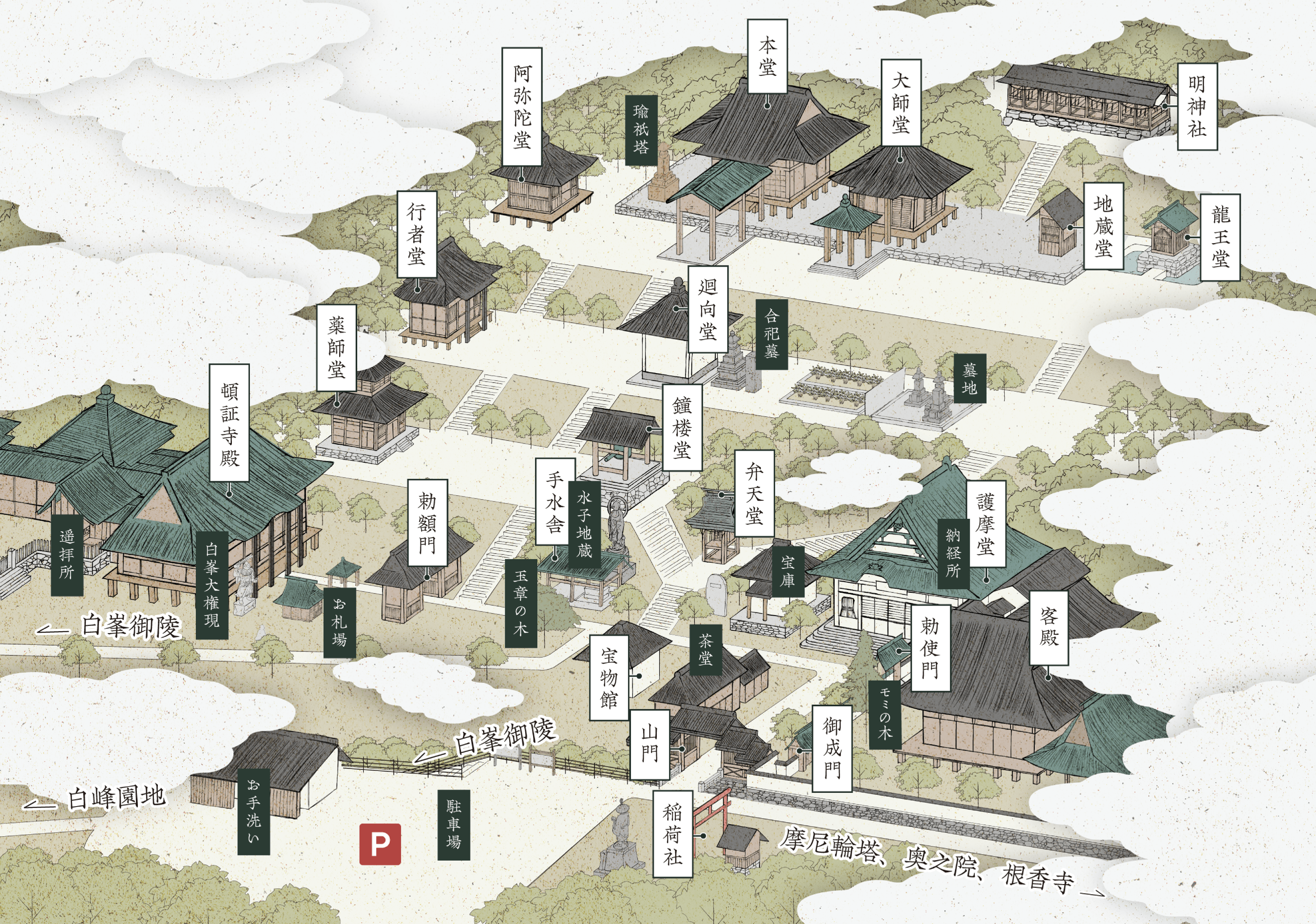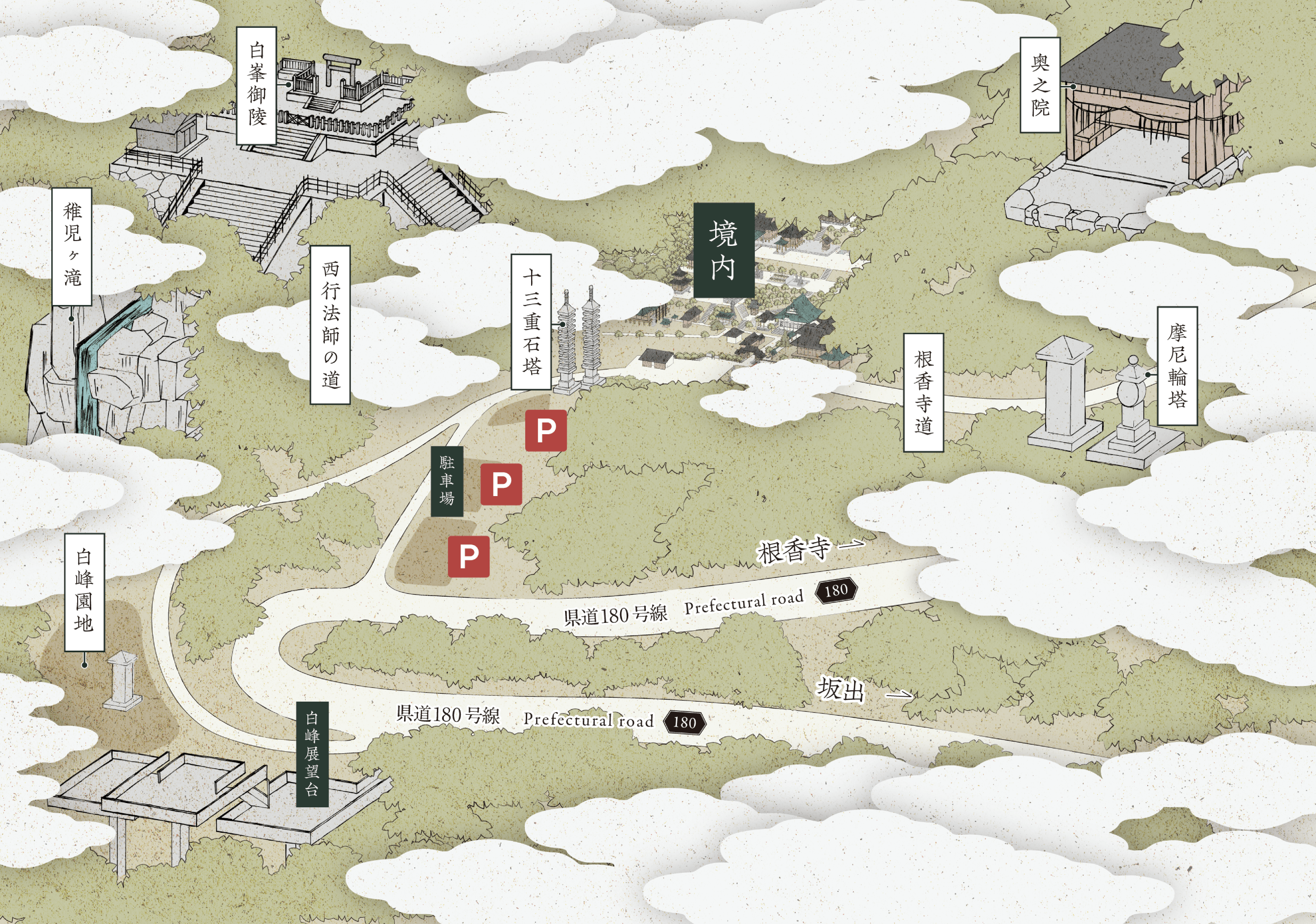THE GROUNDS
境内のご案内
-
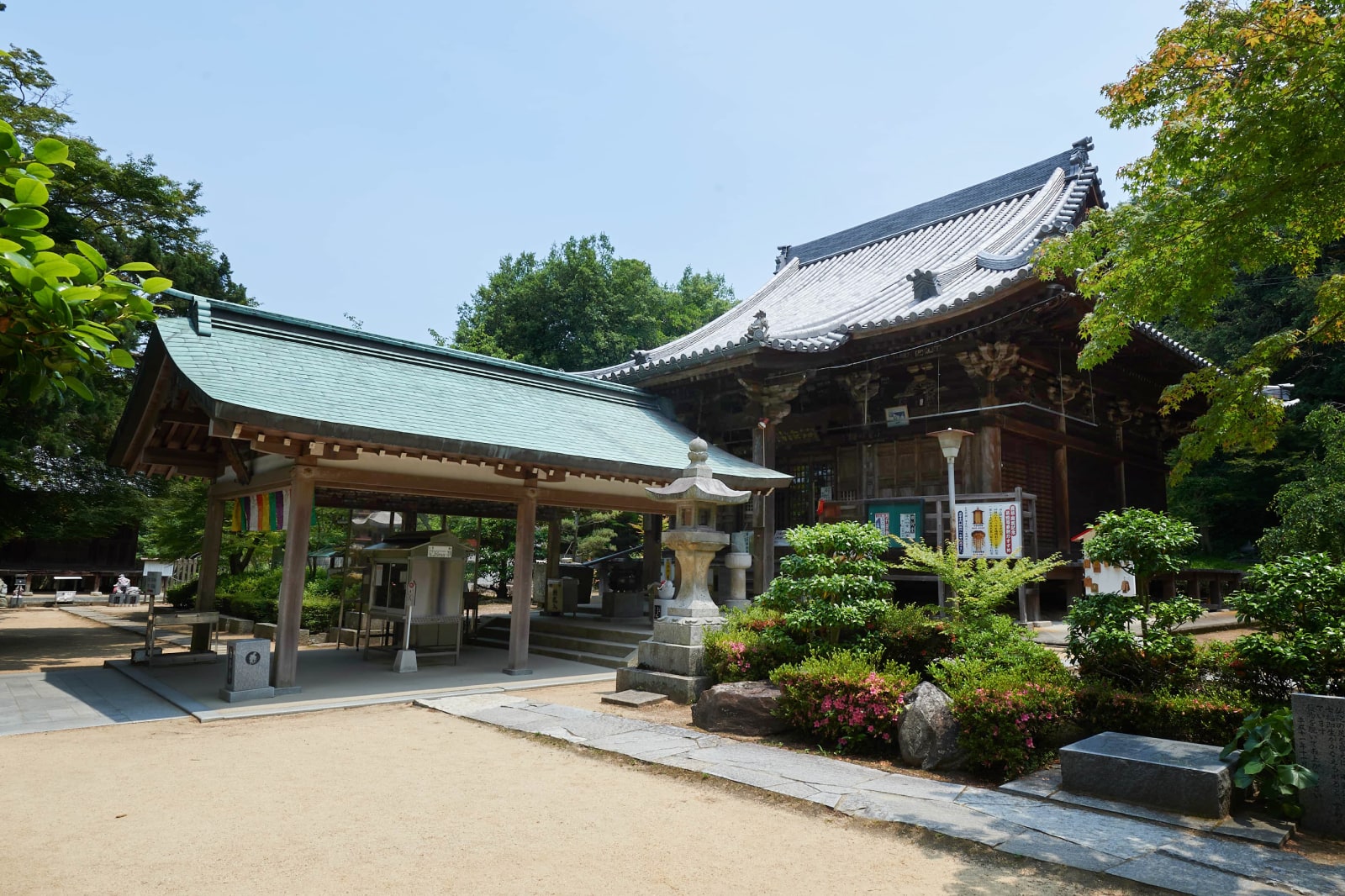
本堂(重要文化財)HONDO (MAIN HALL) (IMPORTANT CULTURAL PROPERTY)
入母屋造の本堂は本尊千手観音菩薩を祀っているので観音堂とも呼ばれ、後嵯峨院の勅号により千手院とも称す。開基以来、数度の火災により消失し、現在のお堂は慶長4年(1599)生駒近規公によって再建されたものである。本尊千手観音菩薩は智証大師(円珍)と、当山鎮守白峯大権現(相模坊)の合作とも伝えられ、脇侍として愛染明王、馬頭観音を祀っている。
子年生まれの守り本尊・七福神のうち毘沙門天The Hondo is also called Kannondo, as it enshrines the principal deity, the thousand-armed Senju Kannon. It was given the name Senju-in by Emperor Go-Saga. Since its founding, the hall has been destroyed several times by fire, and the current building was rebuilt in 1599 by Lord Chikanori Ikoma.
Senju Kannon, the principal deity, is said to be a collaborative work by Chisho Daishi (Enchin) and the guardian deity of the temple, Shiromine Daigongen. On either side of the central statue are the attendant deities, Aizen Myo-o and Bato Kannon.
Senju Kannon is the guardian deity for those born in the Year of the Rat.
Bishamonten is one of the Seven Lucky Gods.ENGLISHCLOSE -
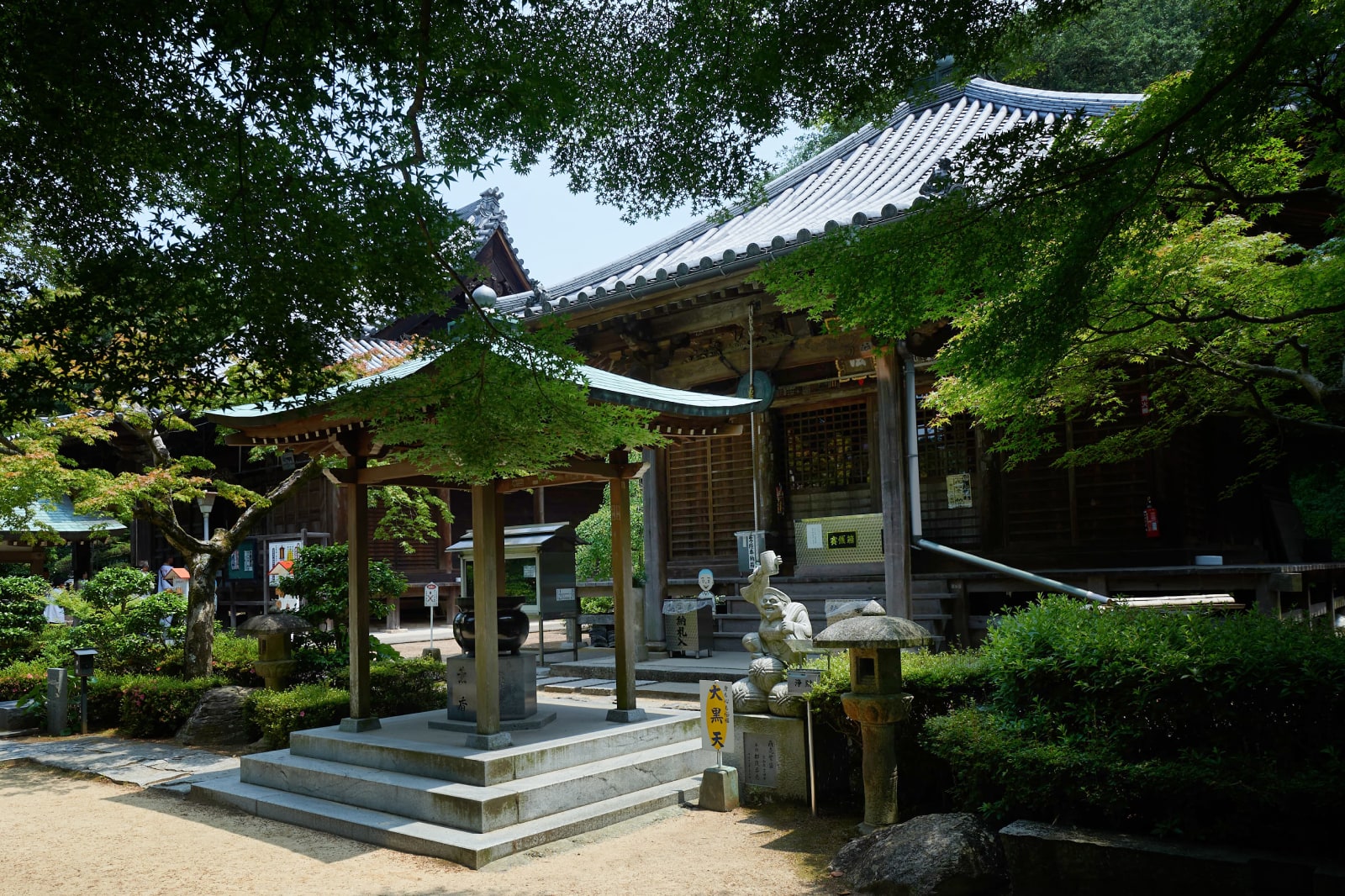
大師堂(重要文化財)DAISHIDO (DAISHI HALL) (IMPORTANT CULTURAL PROPERTY)
宝形造の大師堂は、文化8年(1811)高松藩主松平頼儀公の再建されたお堂で、中央に弘法大師、左に稚児大師像、右に庚申の本地仏青面金剛が三猿と共に祀られている。
七福神のうち大黒天Daishido was reconstructed in 1811 by Matsudaira Yorinori, the lord of the Takamatsu Domain. Kobo Daishi is enshrined in the centre, with Chigo Daishi (Kobo Daishi as a boy) on the left and Shomen Kongo, the deity of Koshin Belief, along with three monkeys, on the right.
Daikokuten is one of the Seven Lucky Gods.ENGLISHCLOSE -
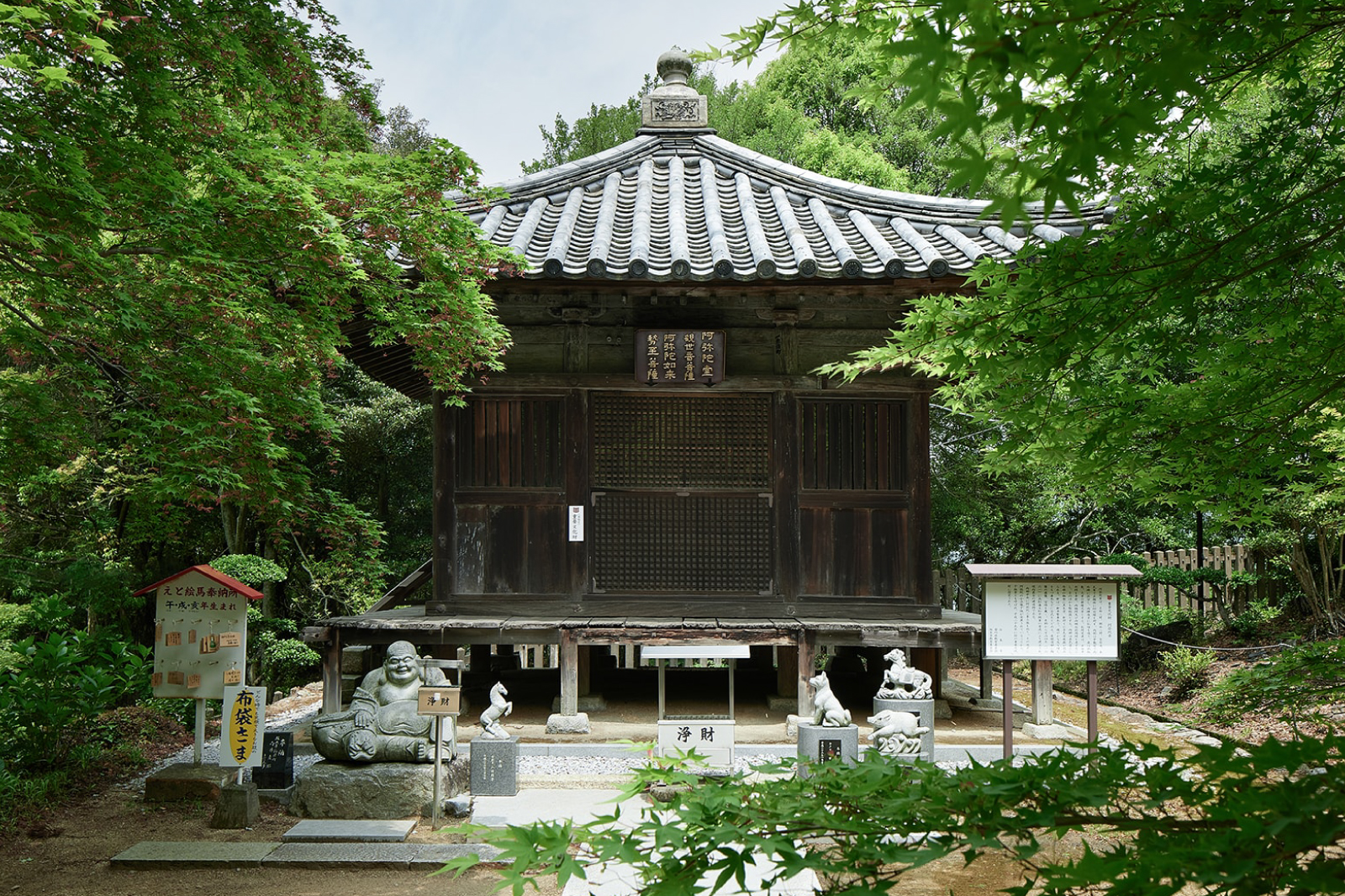
阿弥陀堂(重要文化財)AMIDADO (AMIDA HALL) (IMPORTANT CULTURAL PROPERTY)
万治4年(1661年)建立で、陶製の露盤、宝珠を戴く宝形造である。中央に阿弥陀如来、脇侍に勢至菩薩、観音菩薩を安置し、背後に千体の阿弥陀仏を安置するため別名千体堂とも呼ばれ、境内最古の建物である。
午年、戌年、亥年の守り本尊・七福神のうち布袋尊Built in 1661, Amidado is the oldest building on the temple grounds. Amida Nyorai is enshrined in the centre with Seishi Bosatsu and Kannon Bosatsu on either side. It is also known as Sentaido or Hall of a Thousand Buddhas as it houses a thousand Amida Buddha statues at the rear.
Amida Nyorai is the guardian deity for those born in the Year of the Dog and Year of the Boar, and Seishi Bosatsu is the guardian deity for those born in the Year of the Horse.
Hotei is one of the Seven Lucky Gods.ENGLISHCLOSE -
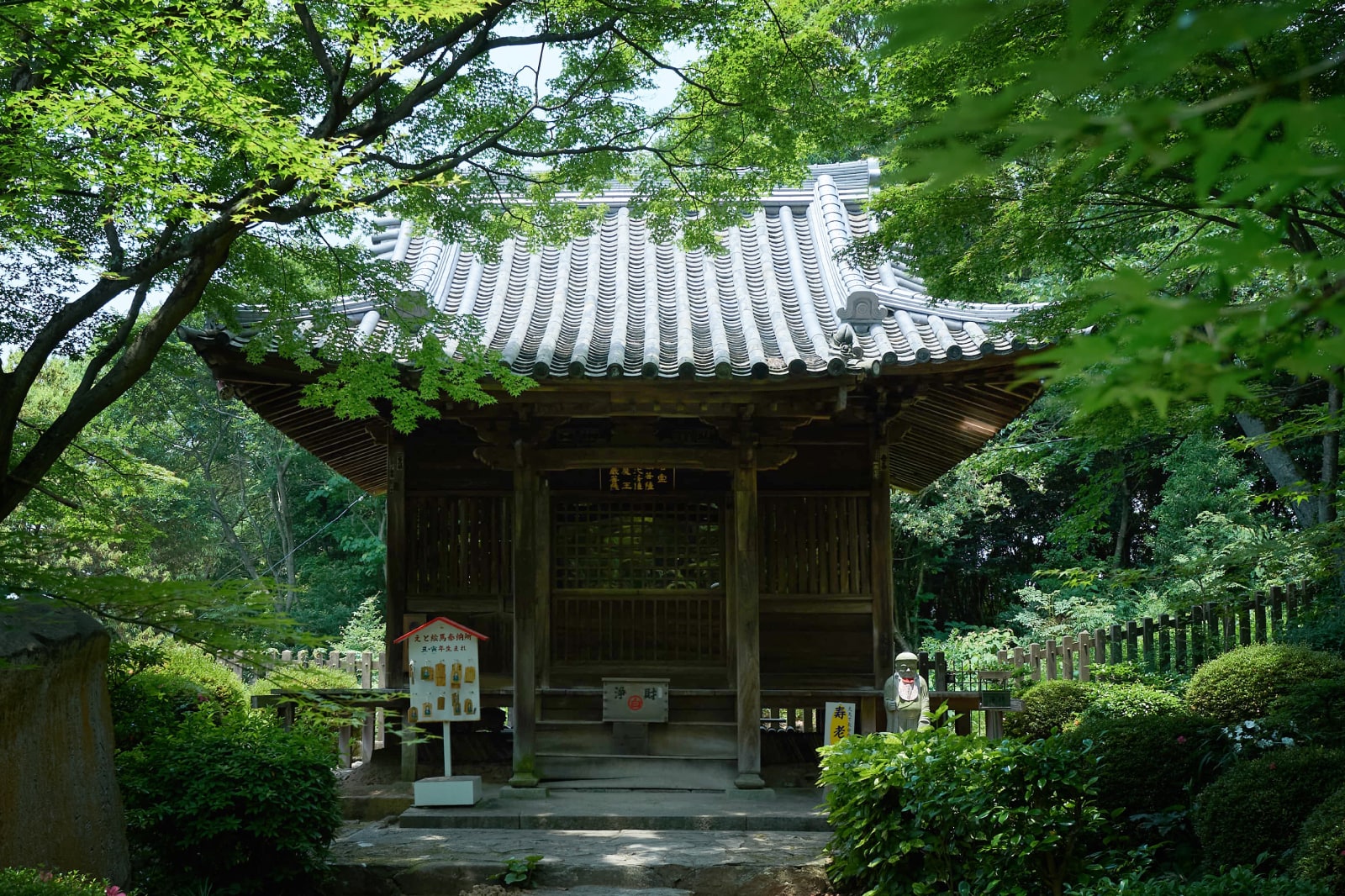
行者堂(重要文化財)GYOJADO (GYOJA HALL) (IMPORTANT CULTURAL PROPERTY)
安永8年(1779年)再建で、入母屋造である。中央に役行者、周りに閻魔王、十王、司命、司録、脱衣婆、地蔵菩薩、虚空蔵菩薩を安置し、黒漆塗と極彩色を施された厨子を備える。
丑年、寅年の守り本尊・七福神のうち寿老人Gyojado was rebuilt in 1779. En no Gyoja (the founder of Shugendo) is enshrined in the centre, surrounded by Enma-o (King of the Underworld), the Ten Kings of Hell, Shimei (Judgement Reader), Shiroku (Record Taker), Datsueba (Clothes Snatcher), Jizo Bosatsu (Bodhisattva of the Earth) and Kokuzo Bosatsu (Bodhisattva of the Void). There is also a black lacquered and brightly coloured zushi (miniature shrine used to store important Buddhist items) in the hall.
Kokuzo Bosatsu is the guardian deity for those born in the Year of the Ox and Year of the Tiger.
Jurojin is one of the Seven Lucky Gods.ENGLISHCLOSE -
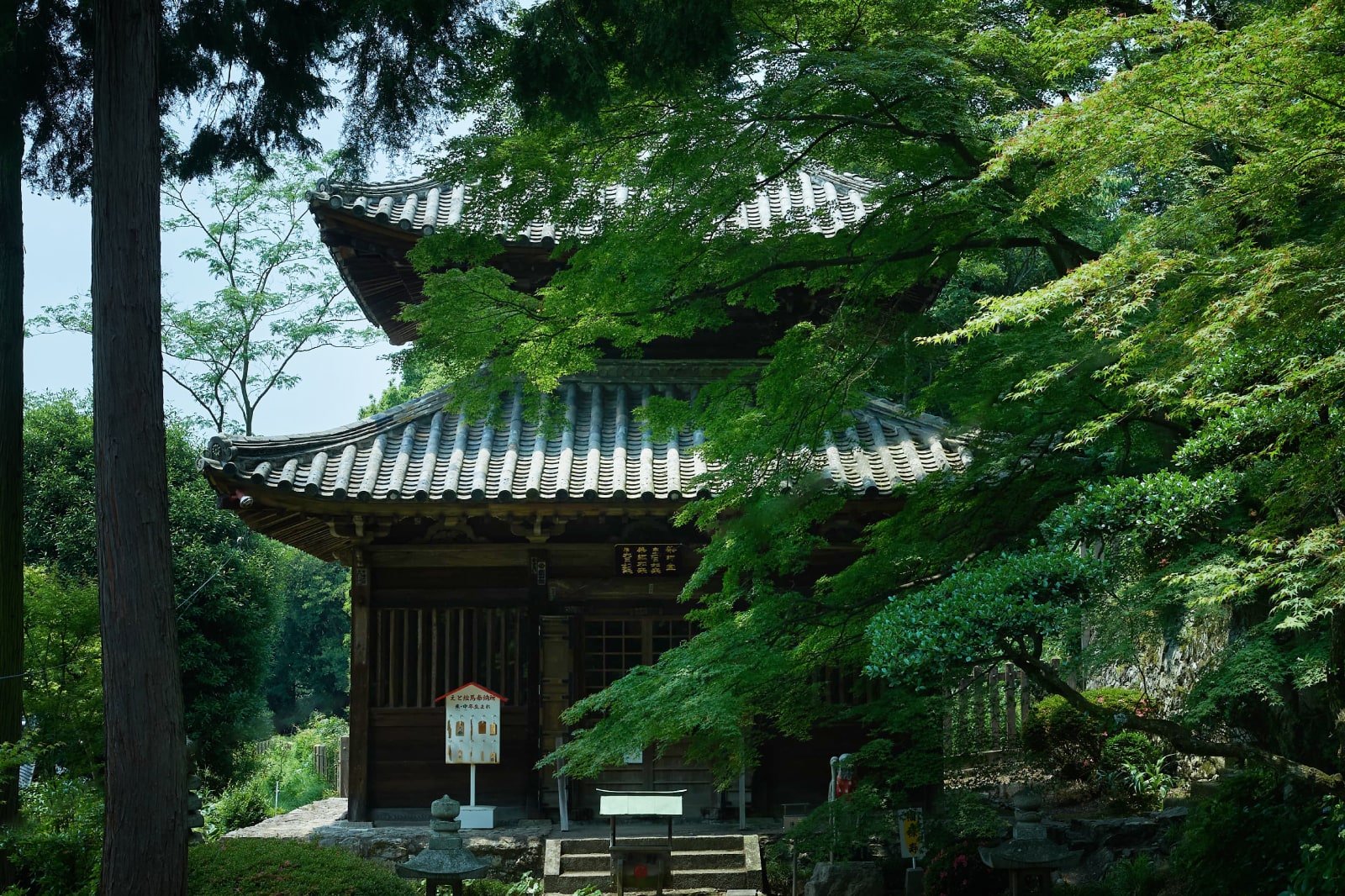
薬師堂(重要文化財)YAKUSHIDO (YAKUSHI HALL) (IMPORTANT CULTURAL PROPERTY)
江戸時代後期の建立とみられ、一層目には裳階を備え、二層の多宝塔形式の宝形造りである。中央に薬師如来、脇侍に日光菩薩と月光菩薩、手前に眷属の十二神将、向かって左側に金剛界大日如来、向かって右側に胎蔵大日如来を安置しており、全体を黒と赤色で彩色する禅宗様を基調とした壮麗な厨子を備える。
未年、申年の守り本尊・七福神のうち福禄寿Believed to have been built in the late Edo period (Edo period: 1600-1868), Yakushido features a two-storied pagoda-style structure. Yakushi Nyorai (Buddha of Healing) is enshrined in the centre, flanked by Nikko Bosatsu (Bodhisattva of Sunlight) and Gakko Bosatsu (Bodhisattva of Moonlight). The Twelve Divine Generals stand in front as protective deities, with Kongokai Dainichi Nyorai to the left and Taizokai Dainichi Nyorai to the right. The hall has a magnificent zushi (miniature shrine used to store important Buddhist items) in Zen-style black and red.
Dainichi Nyorai is the guardian deity for those born in the Year of the Sheep and Year of the Monkey.
Fukurokuju is one of the Seven Lucky Gods.ENGLISHCLOSE -
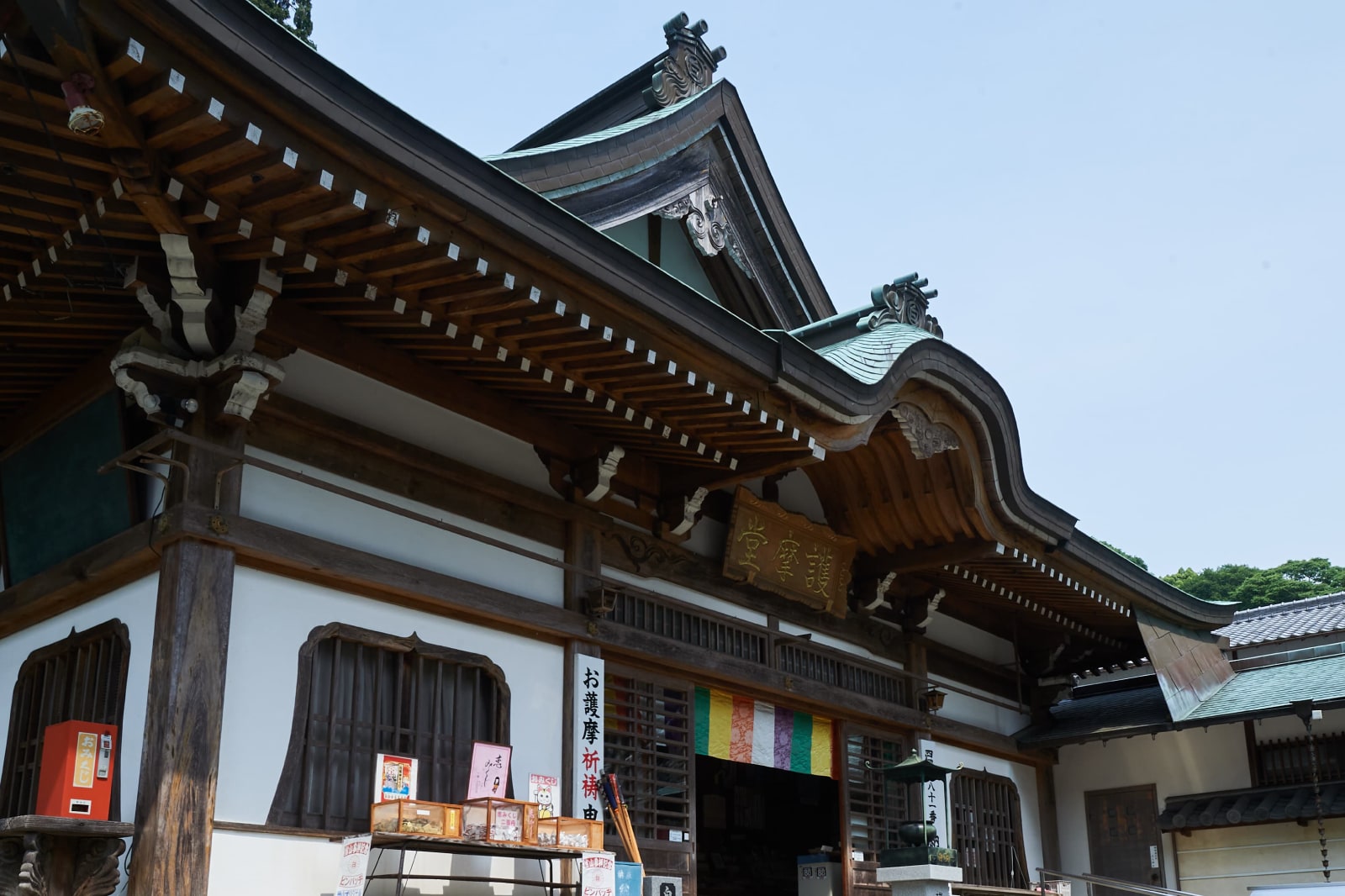
護摩堂GOMADO (GOMA HALL)
昭和61年(1986年 )建立の護摩堂は中央に五大明王、毘沙門天、左に普賢菩薩、弘法大師、蔵王権現、右に阿弥陀如来、歴代高松藩主、歴代先師の位牌を安置し、堂内にお守りの授与所、納経所を併設している。本堂、大師堂は長い石段の上にあるため、足腰に不安がある方は堂内の中央に本尊と向かって左側に大師像の分身があり参拝できる。元の不動堂は高松市塩江町の最明寺に移され、観音堂としてお祀りされている。
辰年、巳年、酉年の守り本尊Built in 1986, Gomado enshrines the Five Wisdom Kings and Bishamonten in the centre, with Fugen Bosatsu, Kobo Daishi and Zao Gongen on the left, and Amida Nyorai on the right, together with memorial tablets of successive lords of theTakamatsu Domain and past teachers. The hall also houses an amulet office and a nokyosho (stamp office).
As the Hondo and Daishido are located at the top of a long flight of stone stairs, alternatively you may prefer to worship the statues of the principal deity and Kobo Daishi, in the centre and on the left respectively, in Gomado.
The original Fudodo (Hall of Fudo Myo-o) was relocated to Saimyoji Temple in Shionoe, Takamatsu city.
Fugen Bosatsu is the guardian deity for those born in the Year of the Dragon and Year of the Snake, and Fudo Myo-o is the guardian deity for those born in the Year of the Rooster.ENGLISHCLOSE -
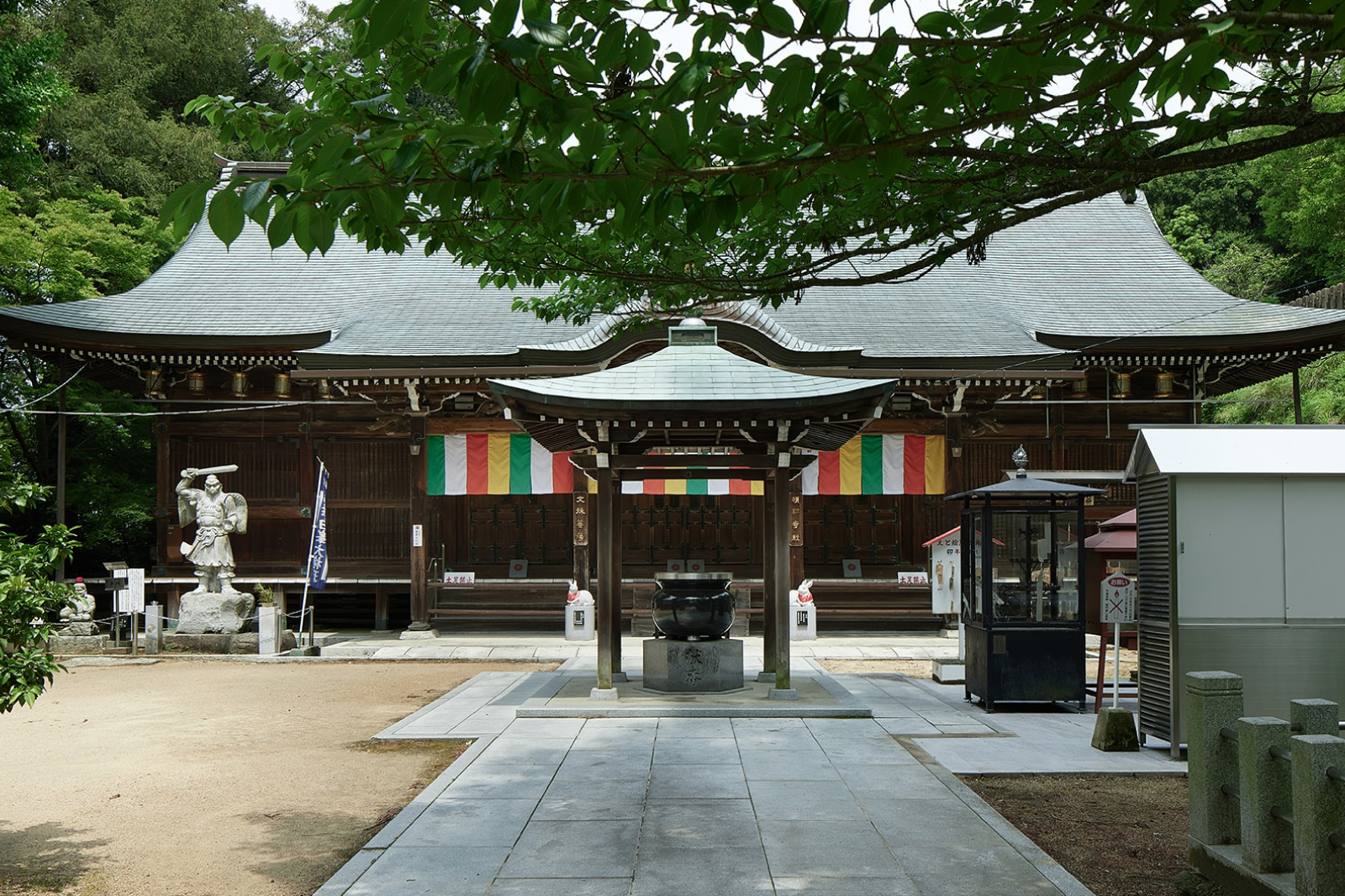
頓証寺殿(重要文化財)TONSHOJIDEN (IMPORTANT CULTURAL PROPERTY)
延宝8年(1680年)建立の崇徳上皇の廟所である頓證寺殿は南面し、文殊菩薩を安置する拝殿の後方に東から念持仏十一面観世音菩薩を祀る本地堂、崇徳上皇を祀る上皇殿、鎮守白峯大権現相模坊を祀る権現堂を配し、拝殿と各堂社を渡廊下で接続するという特異な形態の複合建築である。神社本殿と仏堂の形式を混用した全体構成を持ち、各棟の形式と細部に格式と気品を備えるなど、崇徳上皇崇敬の様相を伝える、稀有な遺構である。
卯年の守り本尊・七福神のうち恵比寿天Built in 1680, Tonshojiden, the memorial site of Emperor Sutoku, faces south and is a unique complex of buildings, with Honjido, which enshrines the Eleven-Headed Kannon, Jokoden, which enshrines Emperor Sutoku, and Gongendo, which enshrines Shiromine Daigongen, located behind the main worship hall, which enshrines Monju Bosatsu. The halls are connected by a covered passageway.
With its blend of Shinto shrine and Buddhist temple styles, together with the dignity and elegance of each building,Tonshojiden is a rare historical monument that reflects a deep reverence for Emperor Sutoku.
Monju Bosatsu is the guardian deity for those born in the Year of the Rabbit.
Ebisu is one of the Seven Lucky Gods.ENGLISHCLOSE -
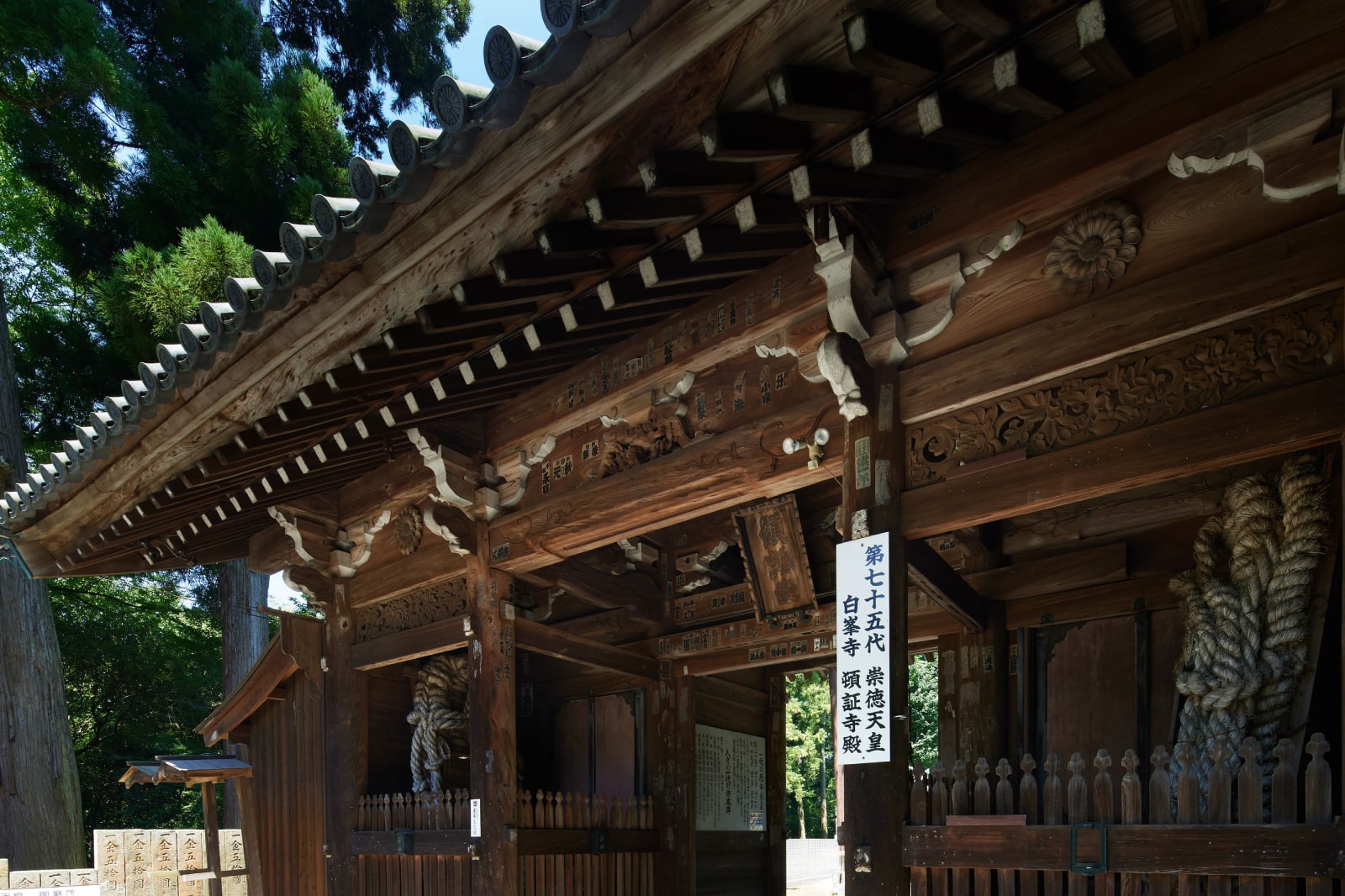
勅額門(重要文化財)CHOKUGAKUMON (IMPERIAL PLAQUE GATE) (IMPORTANT CULTURAL PROPERTY)
延宝8年(1680年)建立の勅額門は細部意匠などから頓証寺殿と一連の造営と考えられる八脚門である。また重要文化財の勅額自体は宝物館にあり、門にはレプリカが掛けられている。向かって左に源為義、右に源為朝の武者像が現在も崇徳院を守護している。なお、現在の像は新たに造立し寄進された像で、元々の像は金刀比羅宮の白峰神社に明治31年に移管され、戻されていない。
Built in 1680, Chokugakumon is an eight-legged gate believed to have been constructed alongside Tonshojiden. The imperial plaque displayed on the gate is a replica; the original, designated as an Important Cultural Property, is preserved in the Homotsukan treasure hall.
Flanking the gate are statues of warriors: Minamoto no Tameyoshi on the left and Minamoto no Tametomo on the right, both symbolically continuing their duty to guard Emperor Sutoku. The current statues are recent replacements, donated to take the place of the originals, which were transferred in 1898 to Shiromine Shrine at Kotohira-Gu (Kompira-san) and have not been returned.ENGLISHCLOSE -
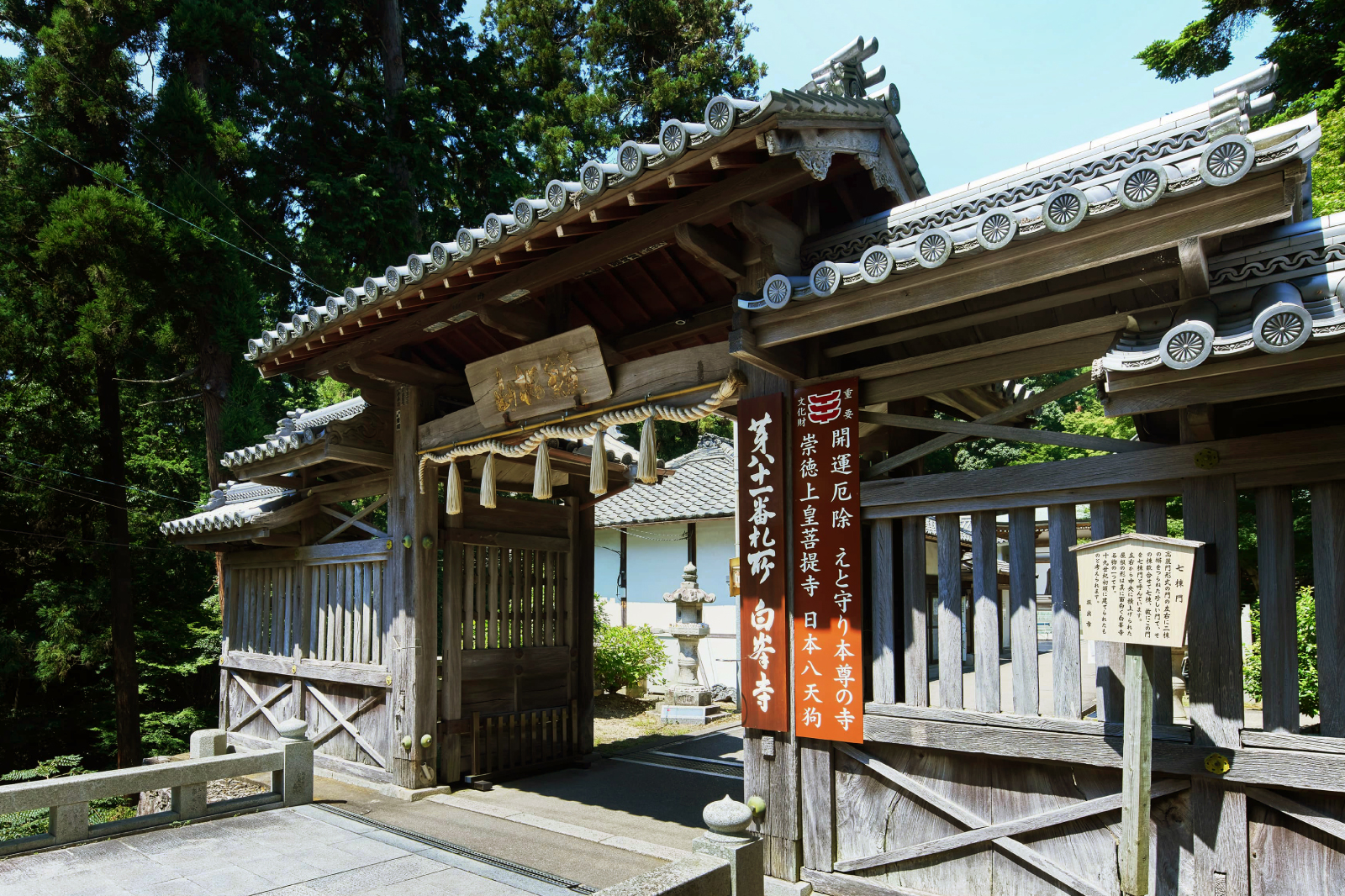
七棟門:山門(重要文化財)NANAMUNEMON (SEVEN-ROOFED GATE) (IMPORTANT CULTURAL PROPERTY)
この山門は江戸時代後期の建立とみられ、切妻造の高麗門で両脇に袖塀を延ばした珍しい門で棟数が全部で7つあることから七棟門と呼ばれており、白峯寺の名物の1つである。嘗ては境内の前後に延びる参道途中に数多くの塔頭に合わせて大門や中門が立ち並んでいたが、時代と共に無くなり今はこの七棟門が山門となっている。
This gate, believed to have been built in the late Edo period (1600-1868), is known as the Seven-Roofed Gate. Featuring a total of seven roof sections, it stands as one of Shiromineji Temple’s most notable landmarks.
In the past, the approach to the temple was lined with numerous sub-temples, each with their own main gates and middle gates. Over time, however, these structures disappeared, leaving the Seven-Roofed Nanamunemon as the temple’s sole main gate today.ENGLISHCLOSE -
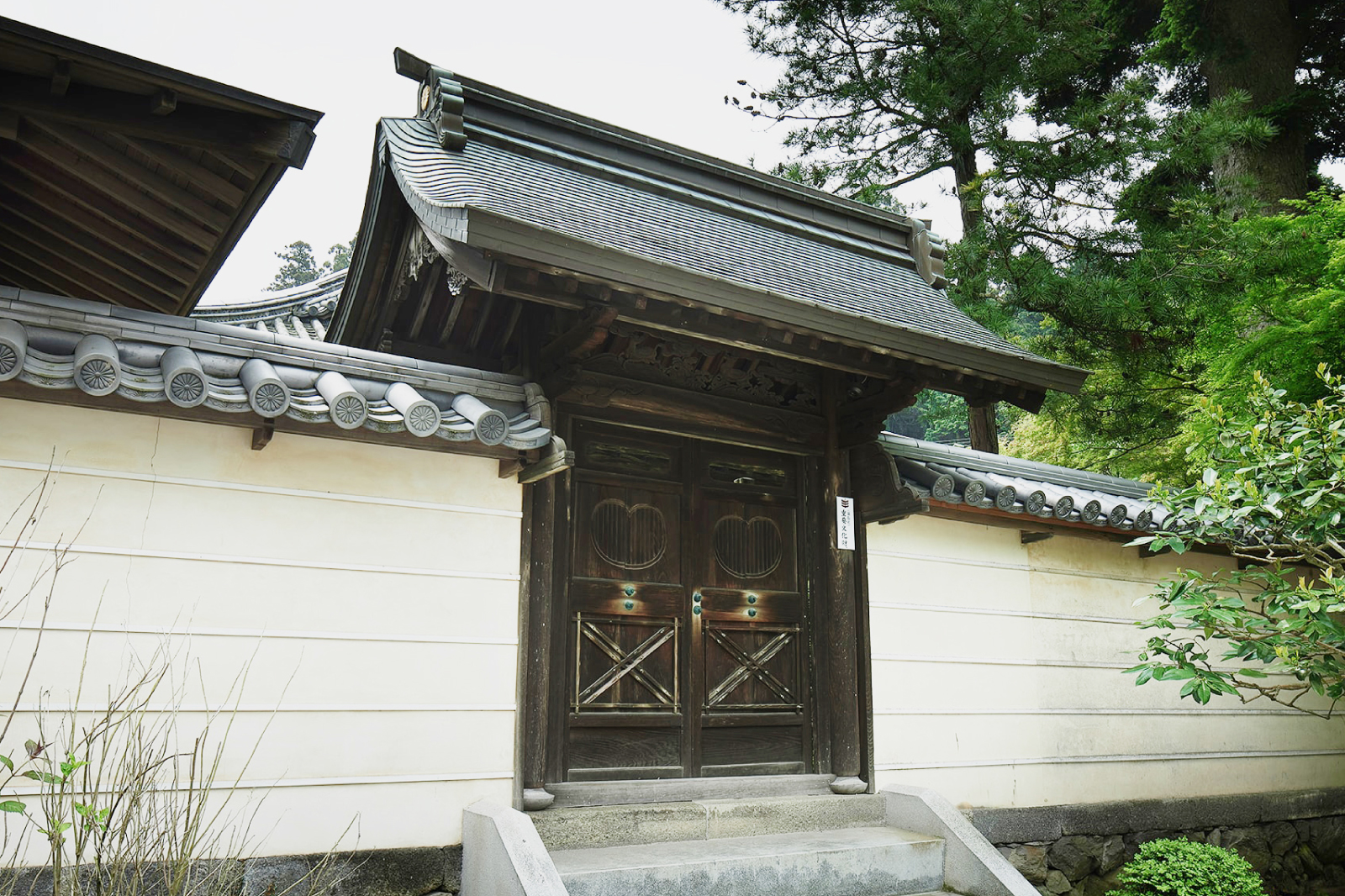
勅使門(重要文化財)CHOKUSHIMON (IMPERIAL MESSENGERS’GATE) (IMPORTANT CULTURAL PROPERTY)
江戸時代後期の建立で、切妻造である。嘗ては都からの勅使が来た際に使用されていた。
Built in the late Edo period (Edo period: 1600-1868), this gable-roofed gate was used by imperial envoys dispatched from the capital.
ENGLISHCLOSE -
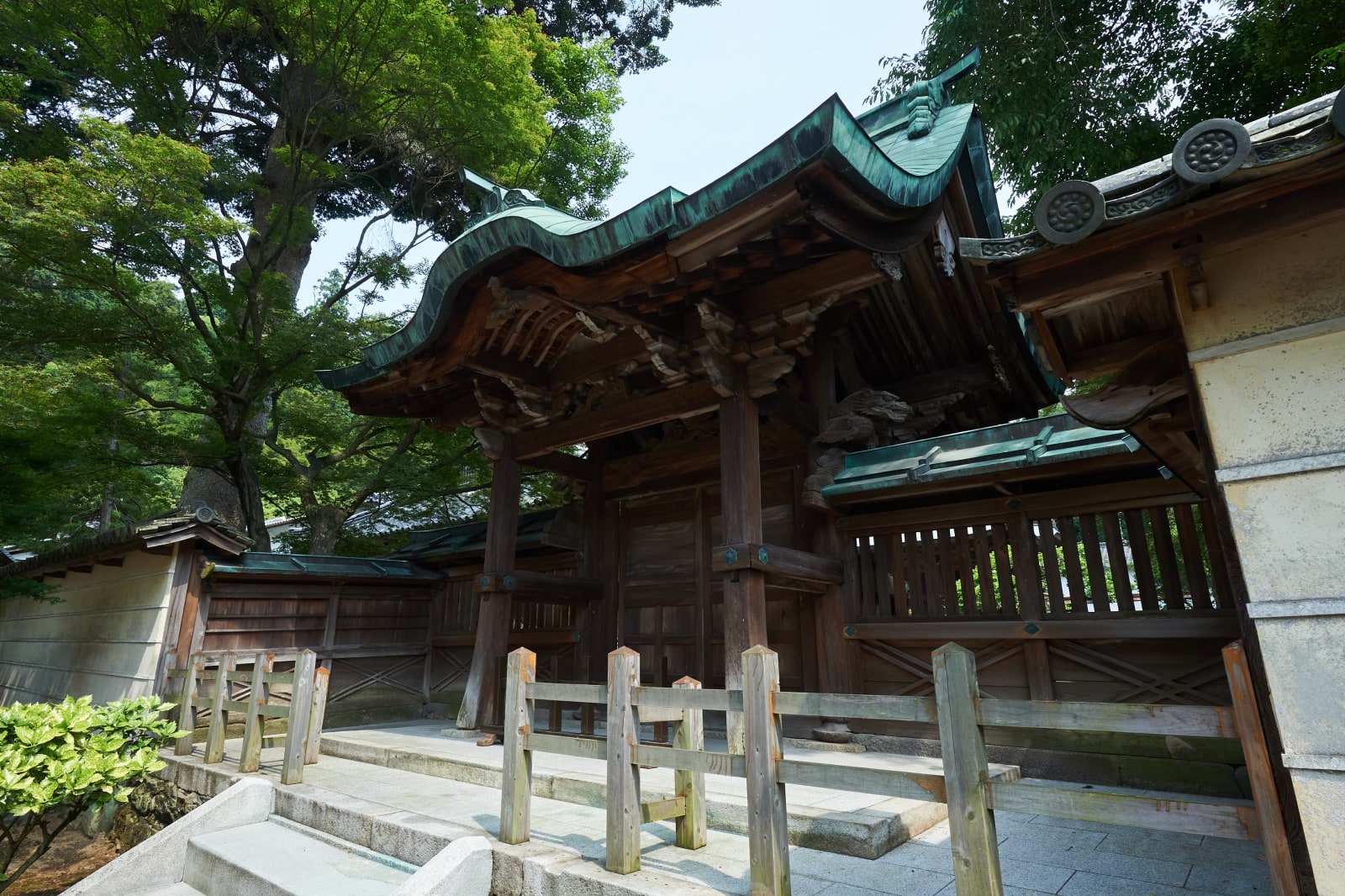
御成門(重要文化財)ONARIMON (GATE FOR DIGNITARIES) (IMPORTANT CULTURAL PROPERTY)
享保9年(1724年)建立された御成門は藩主の御成を想定した客殿の構成用の1つとされ、勅額門同様に技巧的な軸部を構成し、中備の蟇股に仙人を彫るなど、軸部、細部ともに格式高く作り込まれている。
Built in 1724, Onarimon was designed as the gate to the reception hall for visiting feudal lords. Like Chokugakumon, it features a high level of craftsmanship, with intricate carvings, including a depiction of a hermit on the arched struts in the middle.
ENGLISHCLOSE -
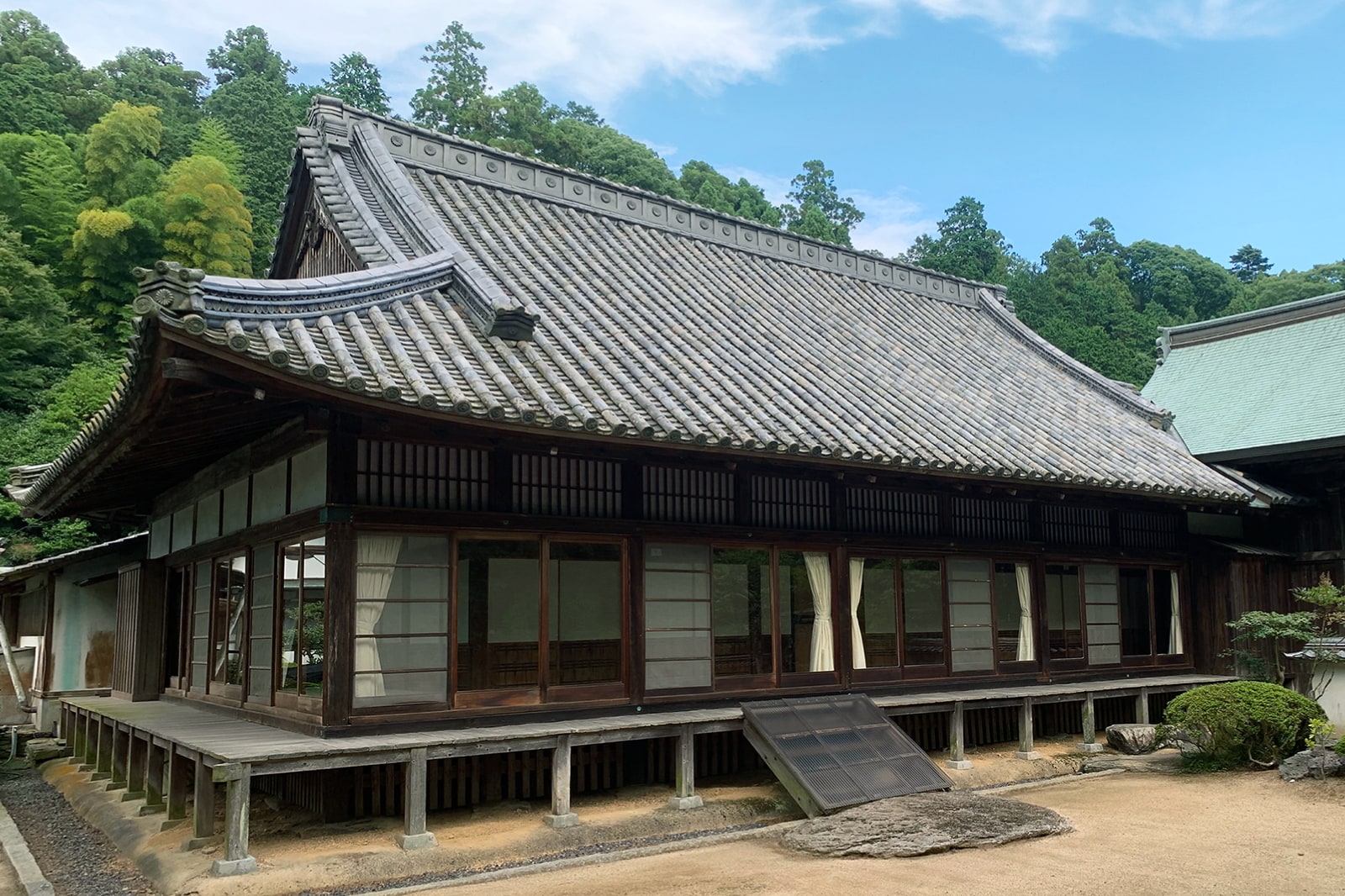
客殿(重要文化財)KYAKUDEN (RECEPTION HALL) (IMPORTANT CULTURAL PROPERTY)
入母屋造で六間取り形式の客殿は頓証寺殿が整備された延宝年間頃に建立され、18世紀中期頃に大玄関を増築したと考えられる。指定文化財では県下2番目に大きく、四国地方では希少な客殿建築であり、藩主の御成を想定した上質な室内構造をもち、御成門と共に壮麗な表構えを形成している。
The six-room Kyakuden dates back to the Enpo era (1673–1681), around the same time Tonshojiden was constructed. The grand entrance is believed to have been added in the mid-18th century. As the second-largest cultural property in the prefecture, it stands as a rare example of reception hall architecture in the Shikoku region.
Designed to host visits by feudal lords, Kyakuden features a refined interior structure and, together with Onarimon, creates a magnificent and stately facade.ENGLISHCLOSE -
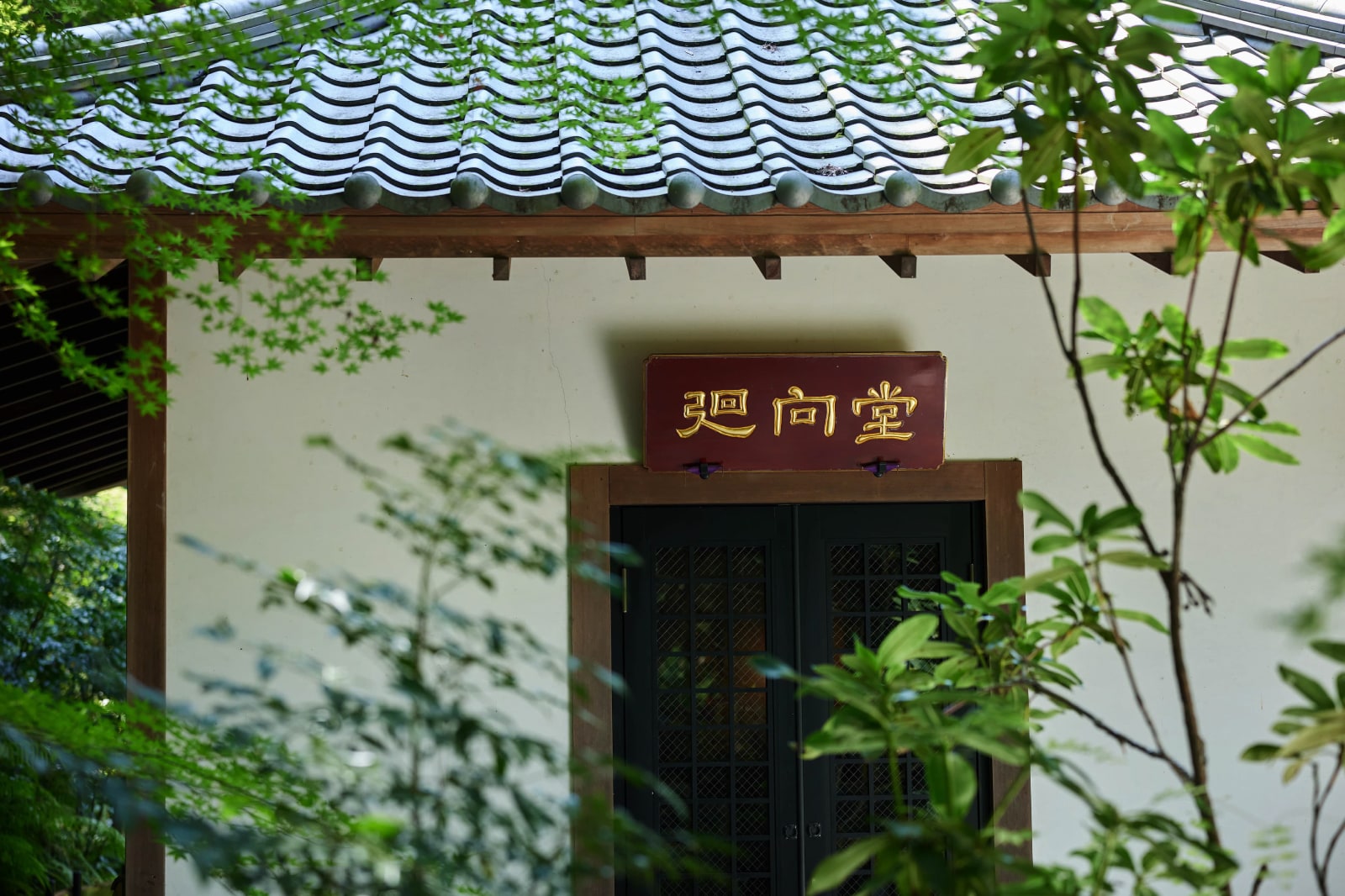
廻向堂EKODO
平成15年(2003年)建立。中央に阿弥陀如来を安置し、本体納骨、分骨納骨、納牌供養にお申込みされた方々の霊を永代に祀るお堂であり、裏には合葬墓、墓地を備える。
Built in 2003, this hall enshrines Amida Nyorai at its centre and serves as a permanent resting place for the spirits of those whose ashes are interred here, either partially or in full, or for whom a mortuary tablet has been dedicated and memorial services requested. Behind the hall lies a shared tomb and a cemetery.
ENGLISHCLOSE -
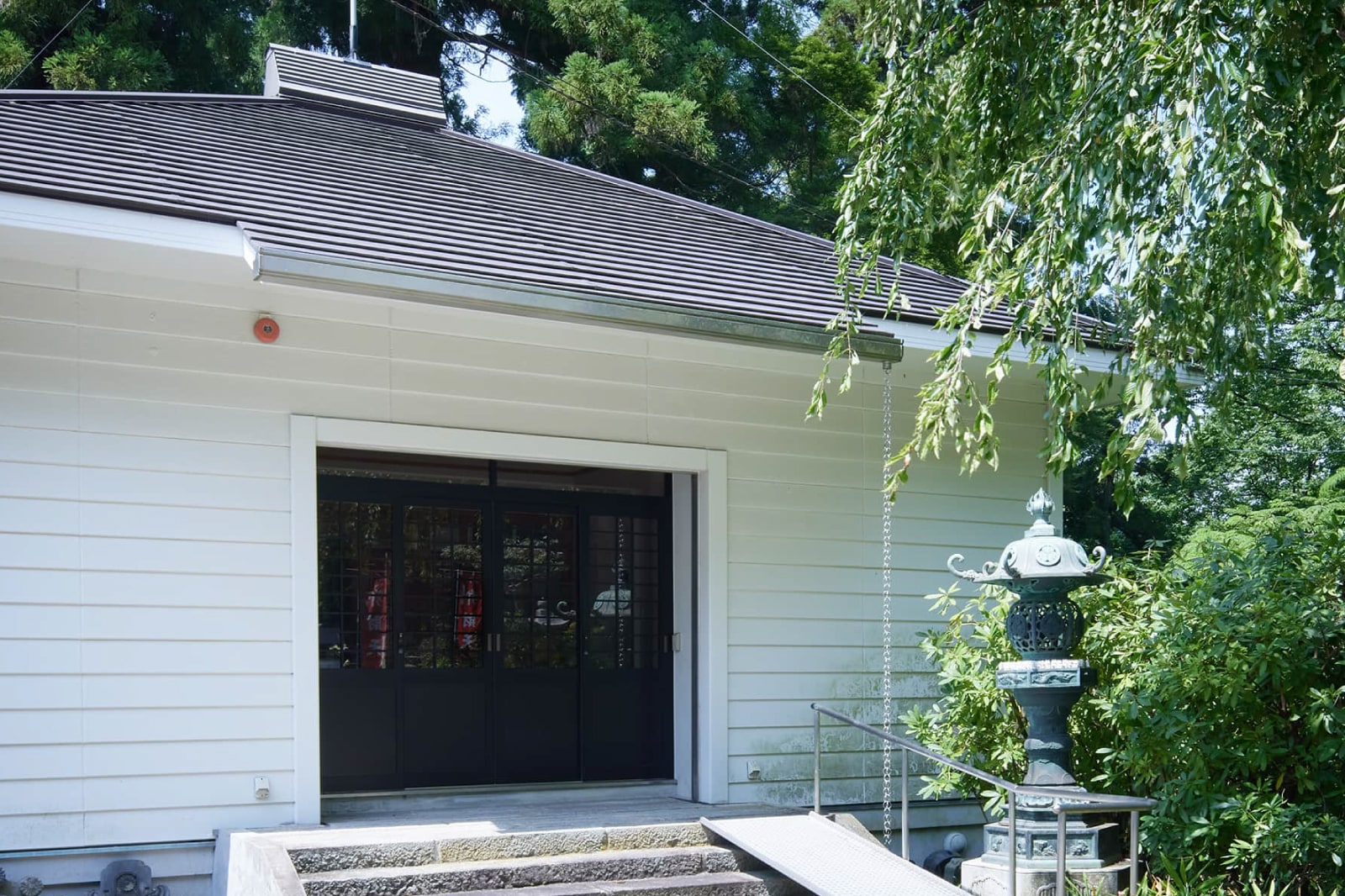
宝物館HOMOTSUKAN (TREASURE HALL)
平成15年(2003年)建立した拝観型のお堂で、重要文化財指定の「勅額」をはじめ、各指定文化財や崇徳天皇にまつわる寺宝などが展示されている。
Built in 2003, the treasure hall was designed to showcase various designated cultural properties, including the Imperial Plaque, an Important Cultural Property, along with temple treasures associated with Emperor Sutoku.
ENGLISHCLOSE -
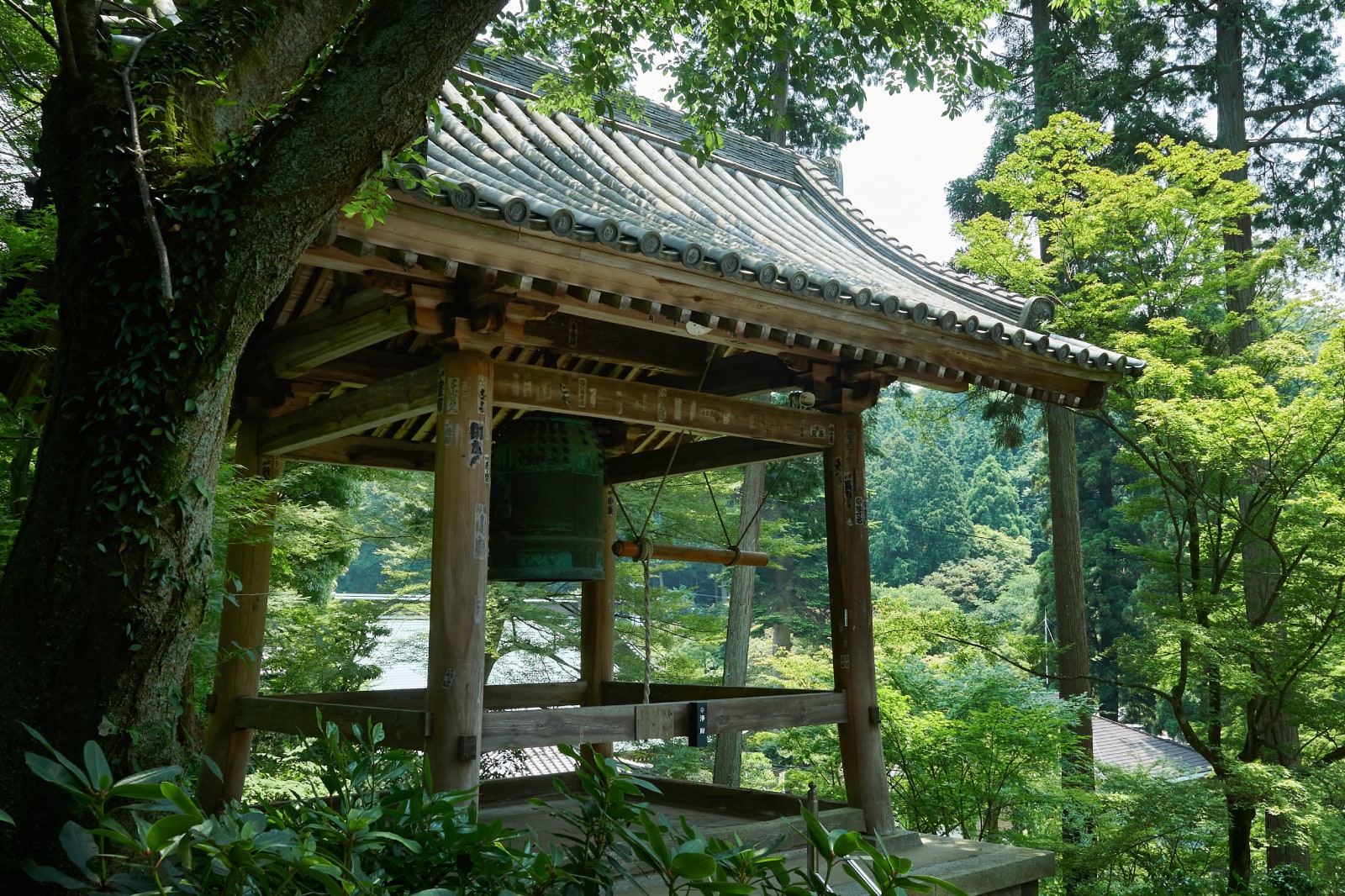
鐘楼堂SHORODO (BELL TOWER)
参拝の際に実際に撞くことができ、大晦日に行う除夜の鐘の行事もここで行われる。
At the Bell Tower, visitors are invited to ring the bell during their visit. This site also hosts the traditional New Year's Eve bell-ringing ceremony.
ENGLISHCLOSE -
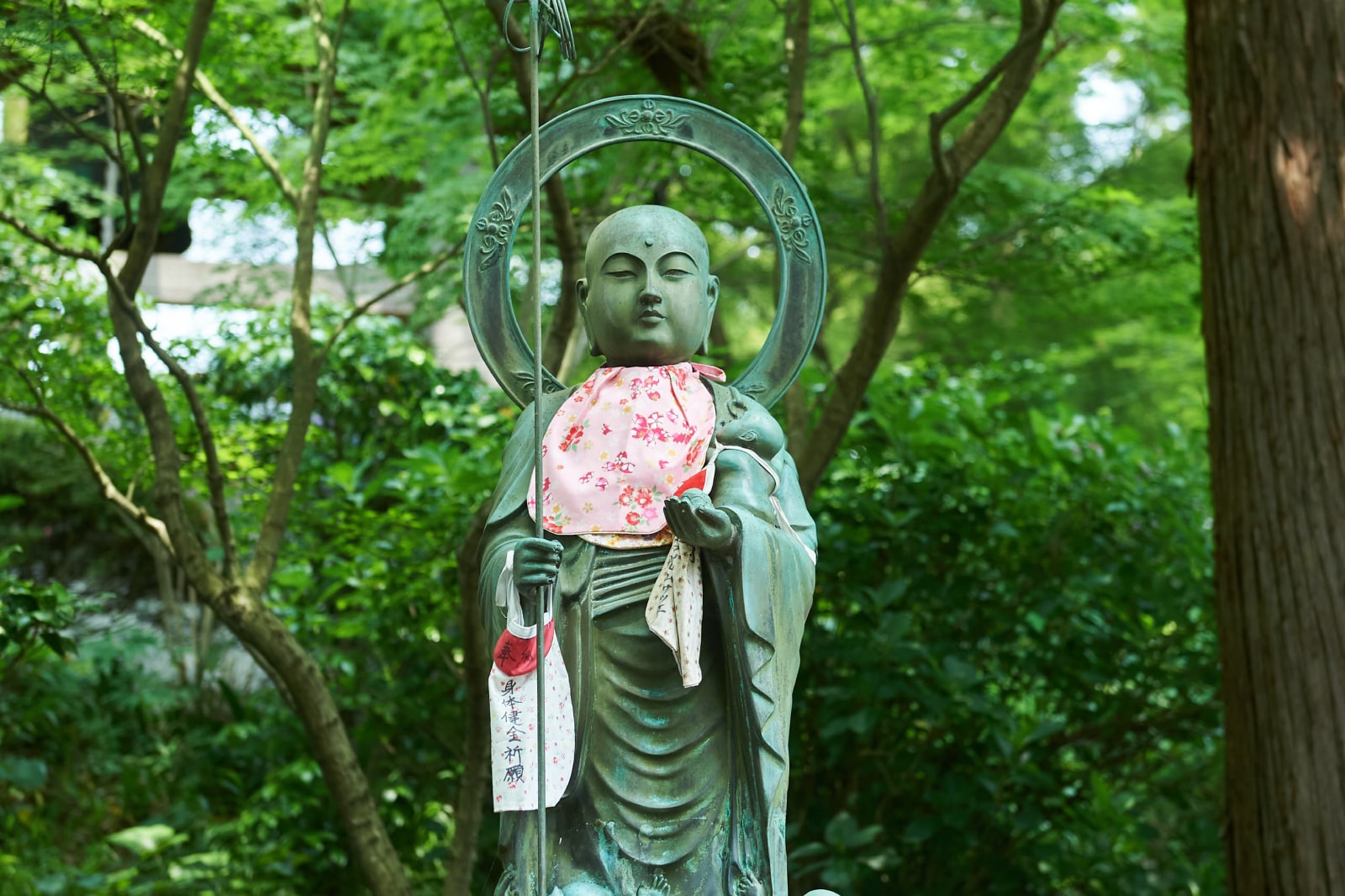
水子地蔵(手水舎)MIZUKO JIZO (CHOZUSHA)
昭和56年(1981年)建立で、申し込みの水子地蔵奉安場所である。また元々境内中にあった五輪塔などを集約してお祀りしている。手水舎を併設しており、石桶にも明治時代の廃仏毀釈の名残を忍ばせる。
This statue and its surrounding area were established in 1981 as a sacred space to enshrine Mizuko Jizo, a Buddhist figure honored as the protector of the souls of unborn or lost children. It also serves as a sanctuary for various objects, including the Gorin-tō, or Five-Storied Pagoda, which were once dispersed across the temple grounds. The site features a Chozusha, or hand-washing station, serving as a poignant reminder of the Meiji-era religious reforms that led to the suppression of Buddhism.
ENGLISHCLOSE -
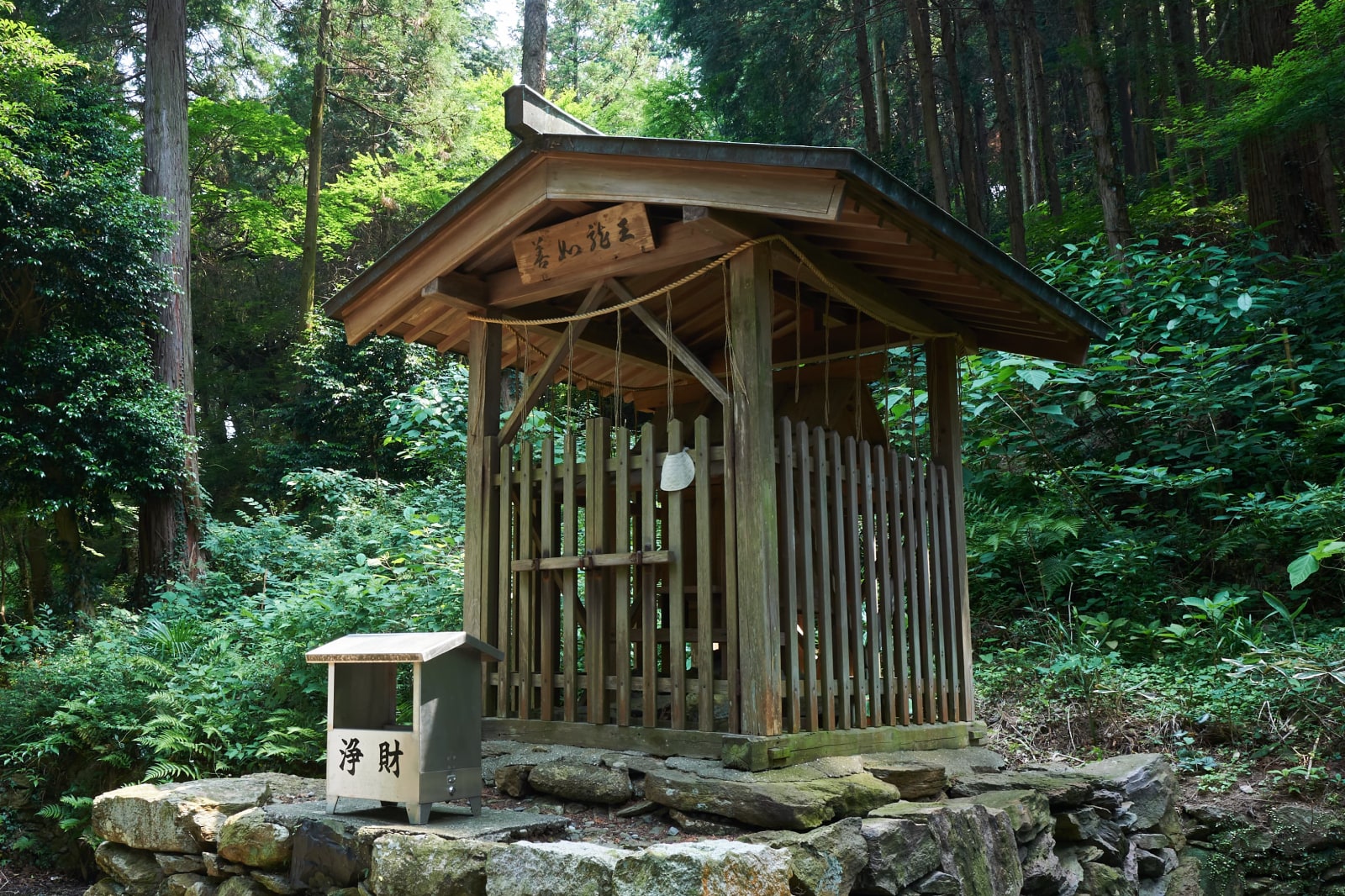
善如龍王堂ZENNYO RYUODO (HALL OF THE RAIN-GOD DRAGON)
安永6年(1777年)再建である。古来より地域における雨乞祈祷の場所として信仰を集めおり、記録によると昭和後期まで行われていた。
Rebuilt in 1777, this hall has long been revered as a sacred place where local people traditionally prayed for rain. Historical records indicate that this custom persisted until the 1970s or 1980s.
ENGLISHCLOSE -
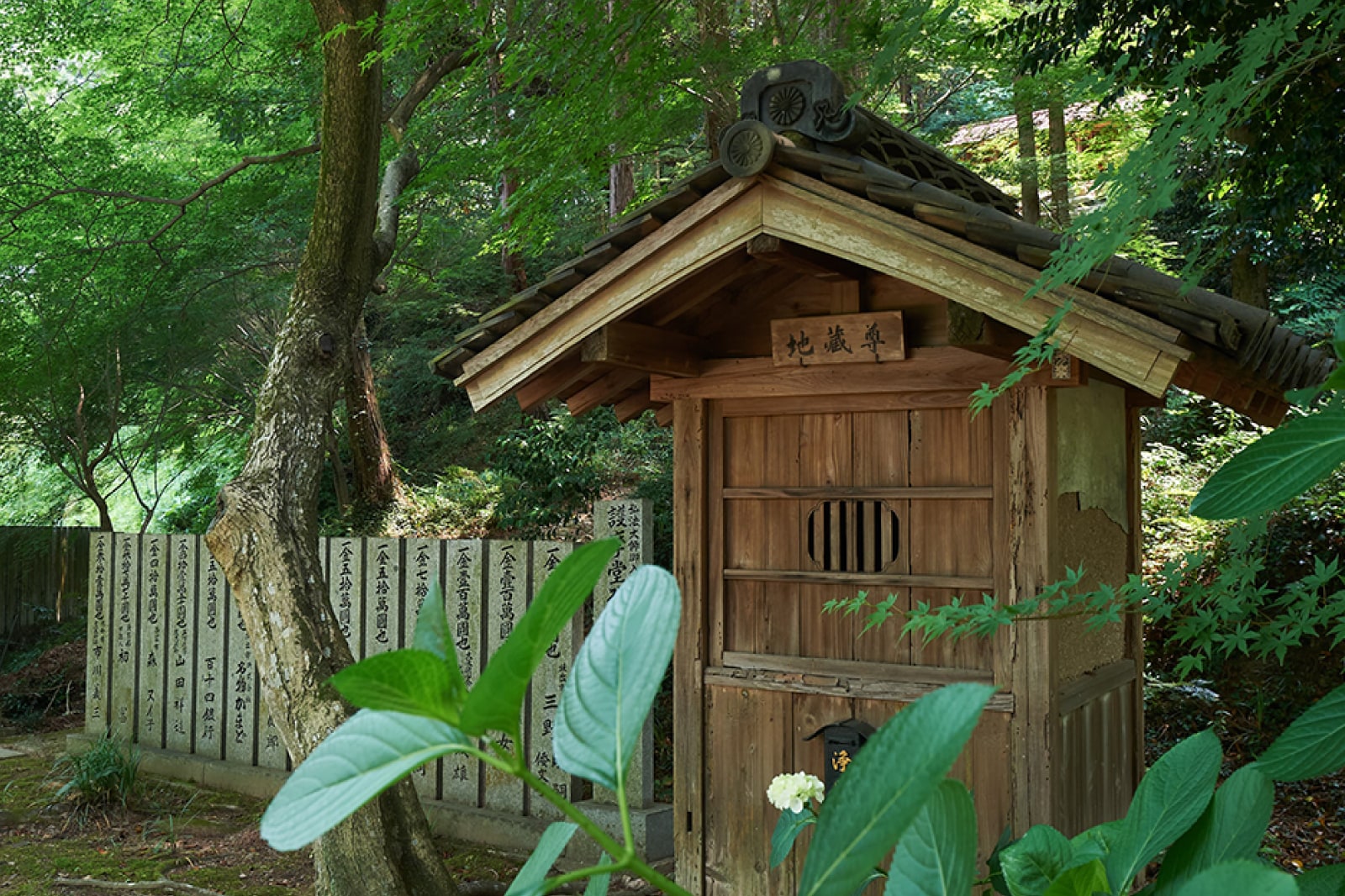
地蔵堂JIZODO (JIZO HALL)
石仏の地蔵菩薩を安置する。軒先瓦には明治時代の廃仏毀釈の名残を忍ばせる。
A stone statue of Jizo Bosatsu, the guardian deity of children and travellers, is enshrined here. The roof tiles on the eaves still bear traces of the anti-Buddhism movement from the Meiji period (1868–1912).
ENGLISHCLOSE -
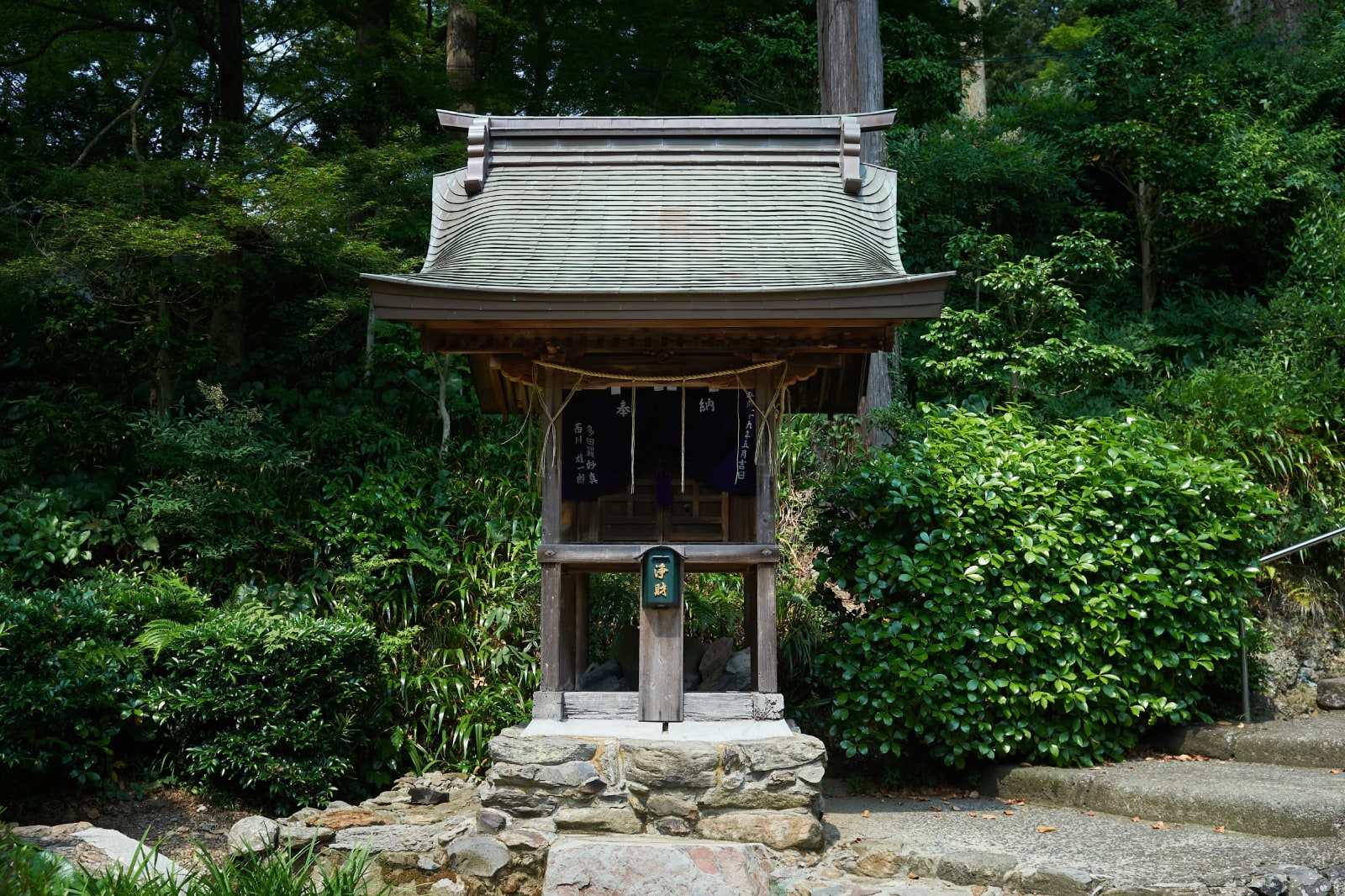
弁天堂BENTENDO (BENTEN HALL)
19世紀前期の建立で、元々の本尊である吉祥天像は県指定文化財のため宝物館に移す代わりに、複製像を安置している。
七福神のうち弁財天Built in the early 19th century, this hall enshrines a replica of Kisshoten, the goddess of happiness, fertility, and beauty. The original statue, designated as a Prefectural Cultural Property, has been relocated to the Homotsukan treasure hall.
Benzaiten is one of the Seven Lucky Gods.ENGLISHCLOSE -
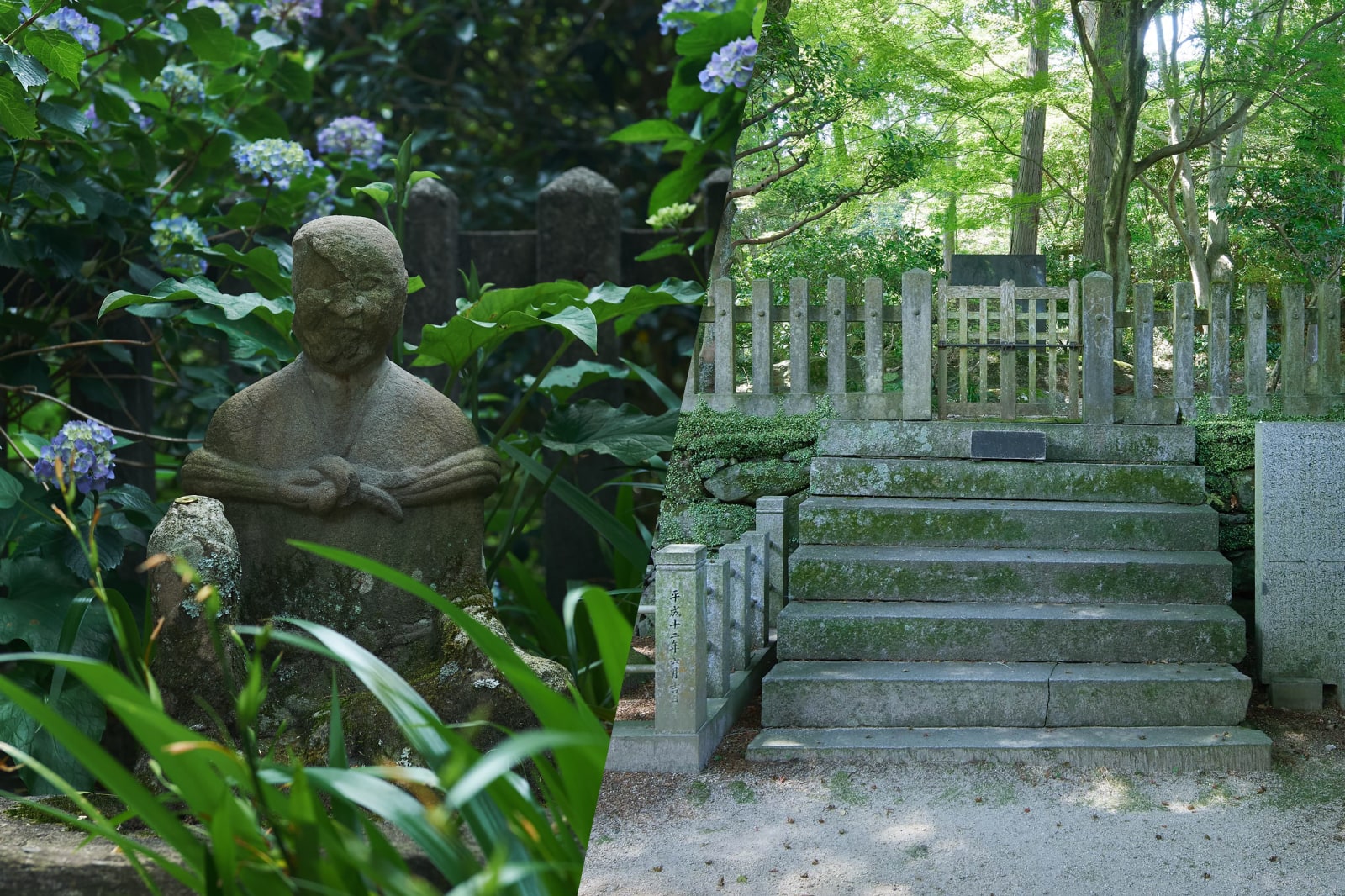
西行法師像と遥拝所SAIGYO HOSHI STATUE AND REMOTE WORSHIP SITE
石造西行法師座像:西行が崇徳上皇を詣でた際に腰掛けたと云われる石に安置されている。傍らに西行「よしや君むかし乃玉のゆかとても かゝらんのちはなにかハせん」がサヌカイトに刻まれた歌碑がある。崇徳天皇白峯陵遥拝所:拝殿の向かって左奥にあり。上皇「濱千鳥あとは都にかよへども身は松山に音をのみぞなく」の歌碑が正面の柵の中にあり、左脇に県指定文化財の頓証寺型石燈籠がある。
A stone statue of the seated poet-monk Saigyo Hoshi rests atop the stone where he is said to have sat while paying homage to Emperor Sutoku. Beside it stands a stone monument inscribed with one of Saigyo's poems:
Even if you were once a jewel,
how could you, in the end, remain untarnished?
What then would become of you?
The remote worship site for Emperor Sutoku’s tomb is located at the rear left of the worship hall. Within the fenced area stands another stone monument, inscribed with a poem by Emperor Sutoku:
I may reach the capital in time,
but my heart remains in Matsuyama,
as sorrow echoes.
On the left is a stone lantern, designated as a Prefectural Cultural Property.ENGLISHCLOSE -
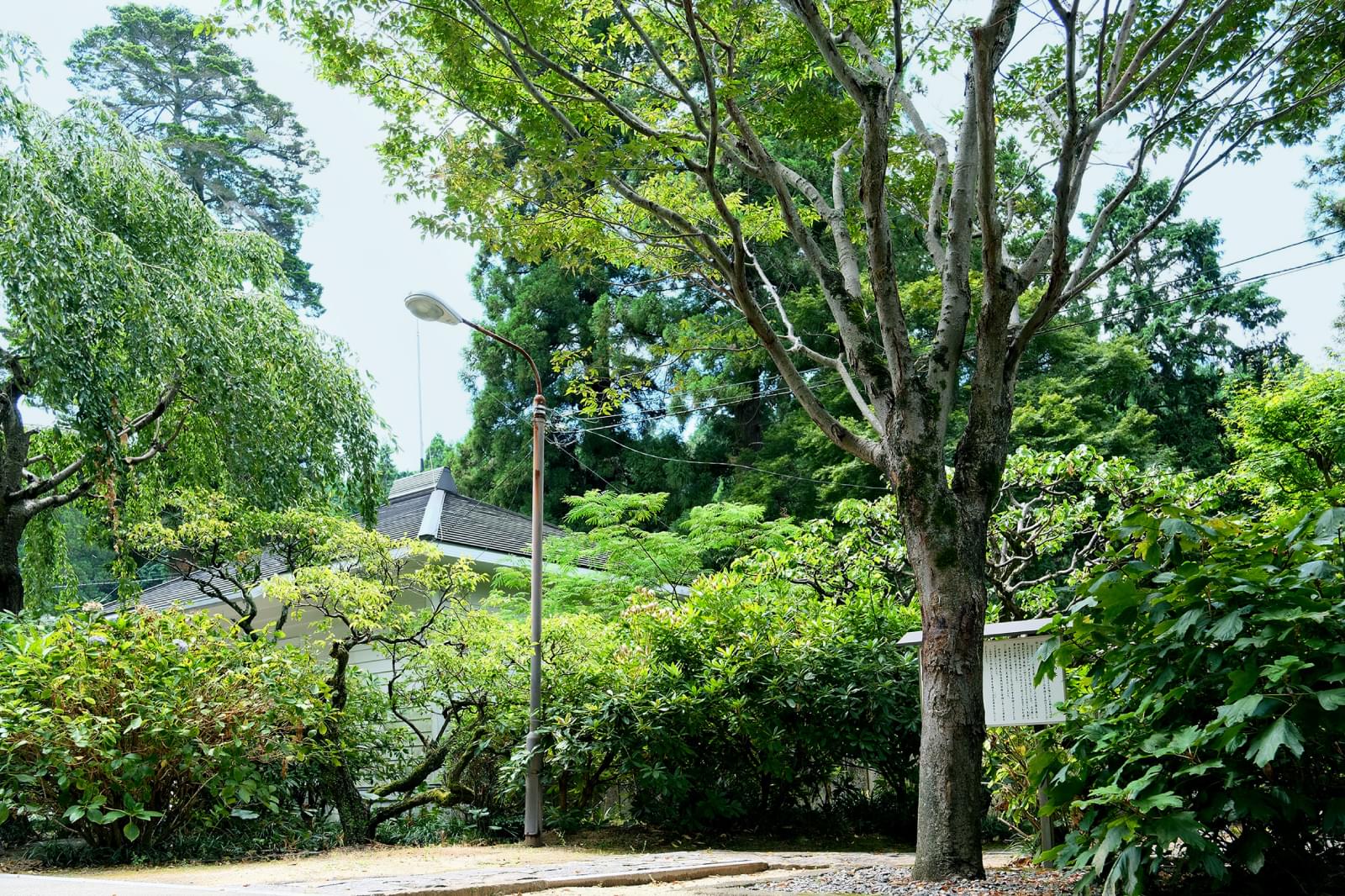
玉章(たまずさ)の木TAMAZUSA TREE (ZELKOVA TREE)
崇徳上皇がほととぎすの鳴き声に都を偲び、和歌を詠んだところ、ホトトギスはその意を察し、嘴に木の葉を巻いて声を忍んで鳴いたといわれる。その巻いた葉が玉章(手紙)に似ているためほととぎすの落とし文、玉章と呼ばれその葉を懐中すれば必ずよい便りがあるといわれ殊に珍重されている。現在の木は古の玉章の木を偲んで植樹されたもので、古木は香川県五色台少年自然センターに寄贈されている。
It is said that Emperor Sutoku, upon hearing the call of a nightingale, was reminded of the capital and, filled with sorrow, composed a poem. Sensing his melancholy, the nightingale wrapped a leaf from the tree around its beak to silence its song. The leaf, resembling a letter or tamazusa, became known as the nightingale’s love letter. It was believed that carrying such a leaf in your pocket would bring good news.
The current tree was planted to replace the original, which was donated to the Goshikidai Youth Nature Centre in Kagawa Prefecture.ENGLISHCLOSE -
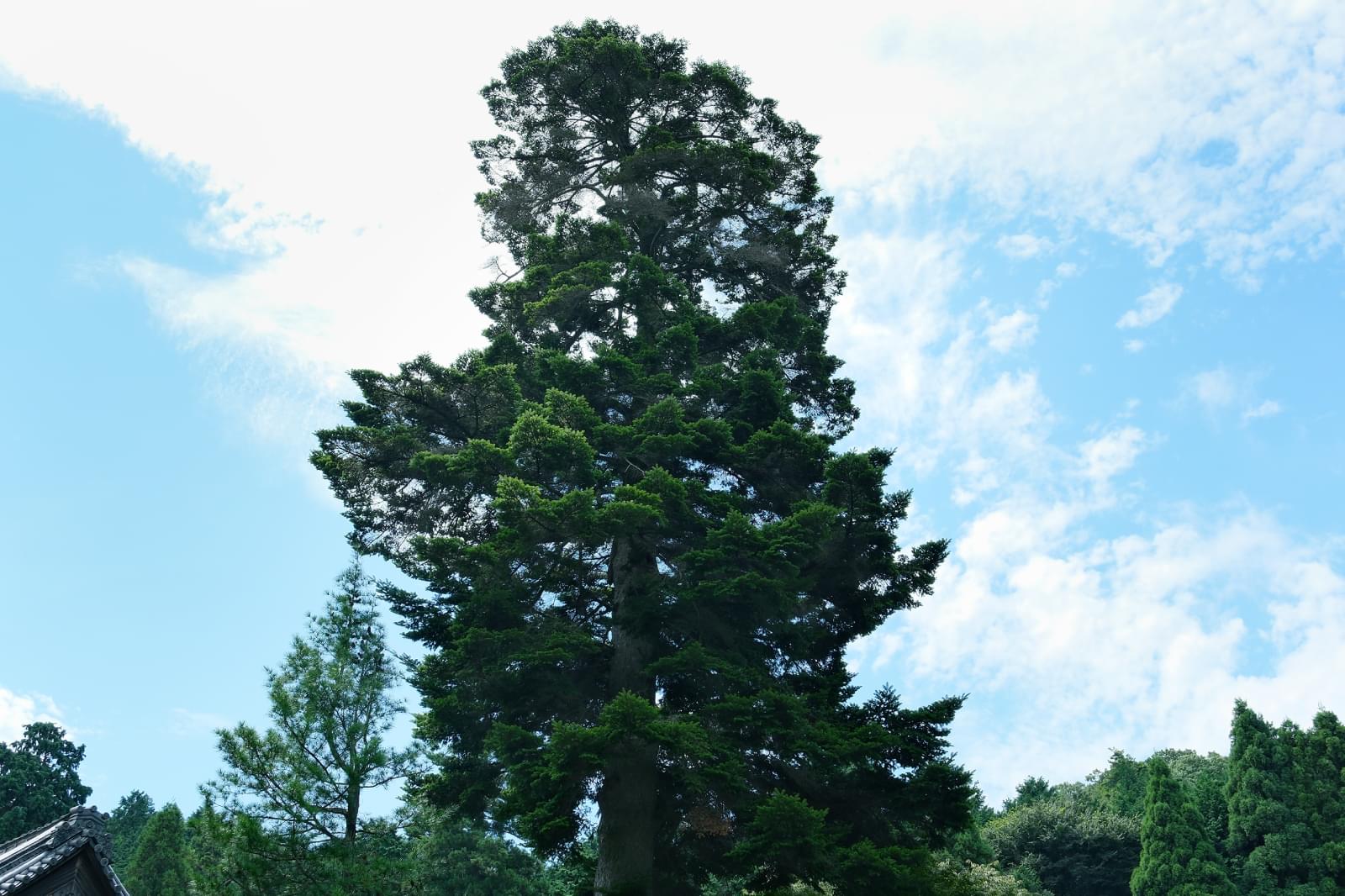
モミの木(県指定保存木)FIR TREE (PREFECTURAL PROTECTED TREE)
通常モミの木の成長限界は約30mとされているが、当山の樹高は約35m、胸高幹周約3.5mあり生育に適した環境下だったため通常より大きく成長したと推察される。昭和54年(1979年)2月27日に県の保存木に指定される。
Normally, the growth limit for fir trees is around 30 metres, but the tree at Shiromineji Temple stands at approximately 35 metres tall, with a trunk circumference of about 3.5 metres at chest height. It is believed that the tree has grown taller than usual due to the favourable environmental conditions. On February 27, 1979, it was designated as a Prefectural Protected Tree.
ENGLISHCLOSE -
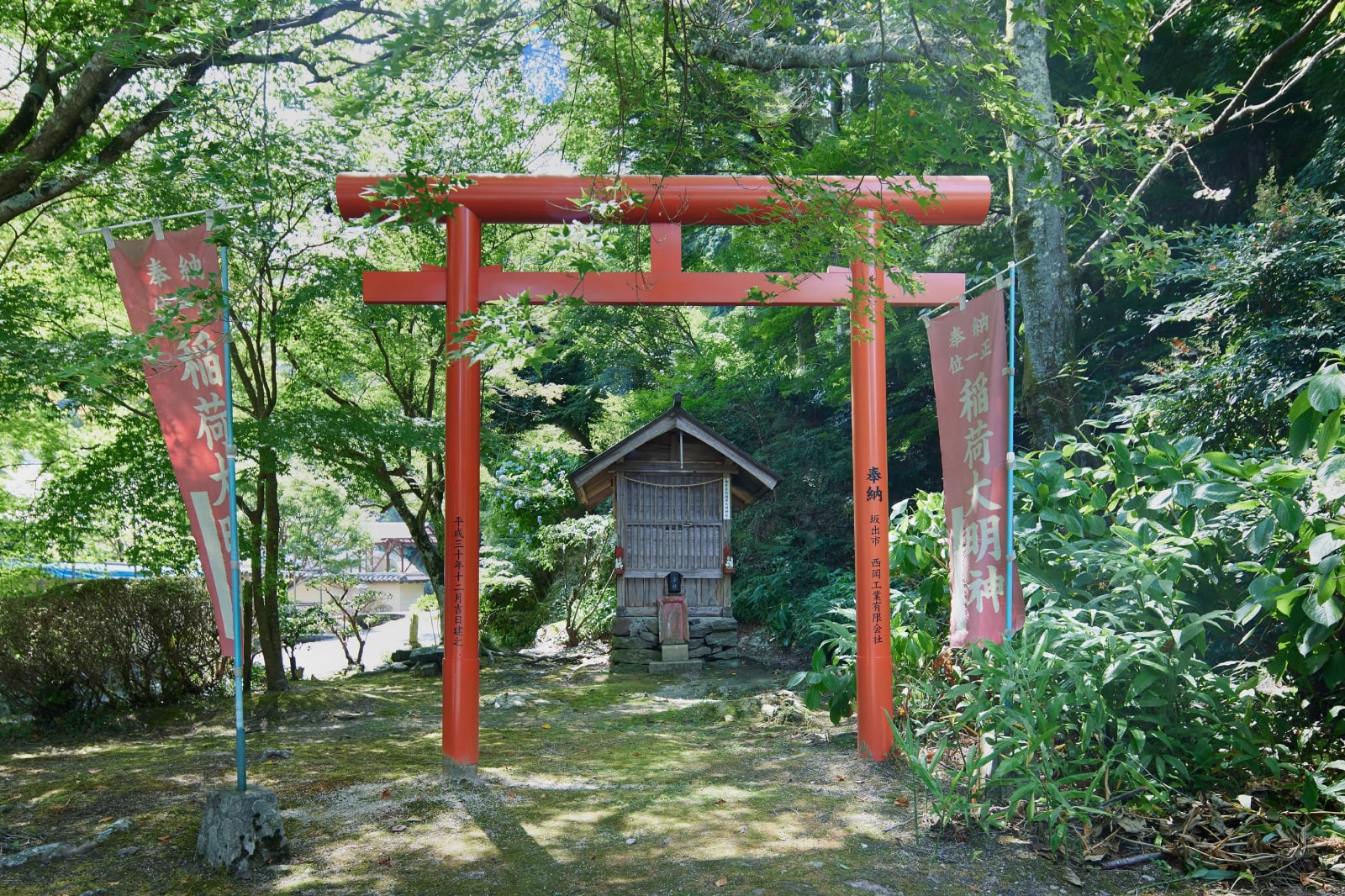
白峯五社稲荷社SHIROMINEGOSHAINARISHA
-
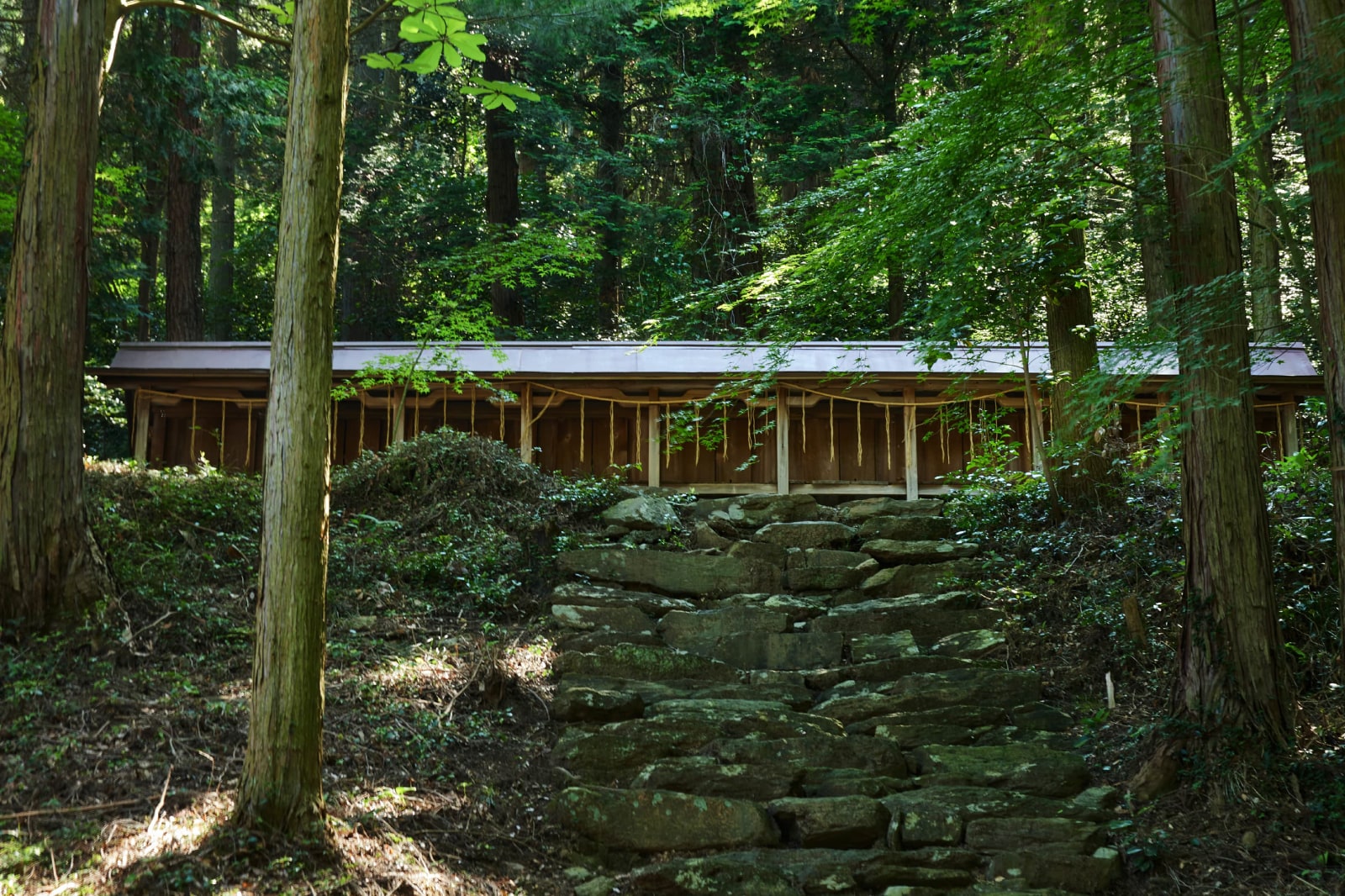
九社明神社KUSHAMYOJINSHA
-
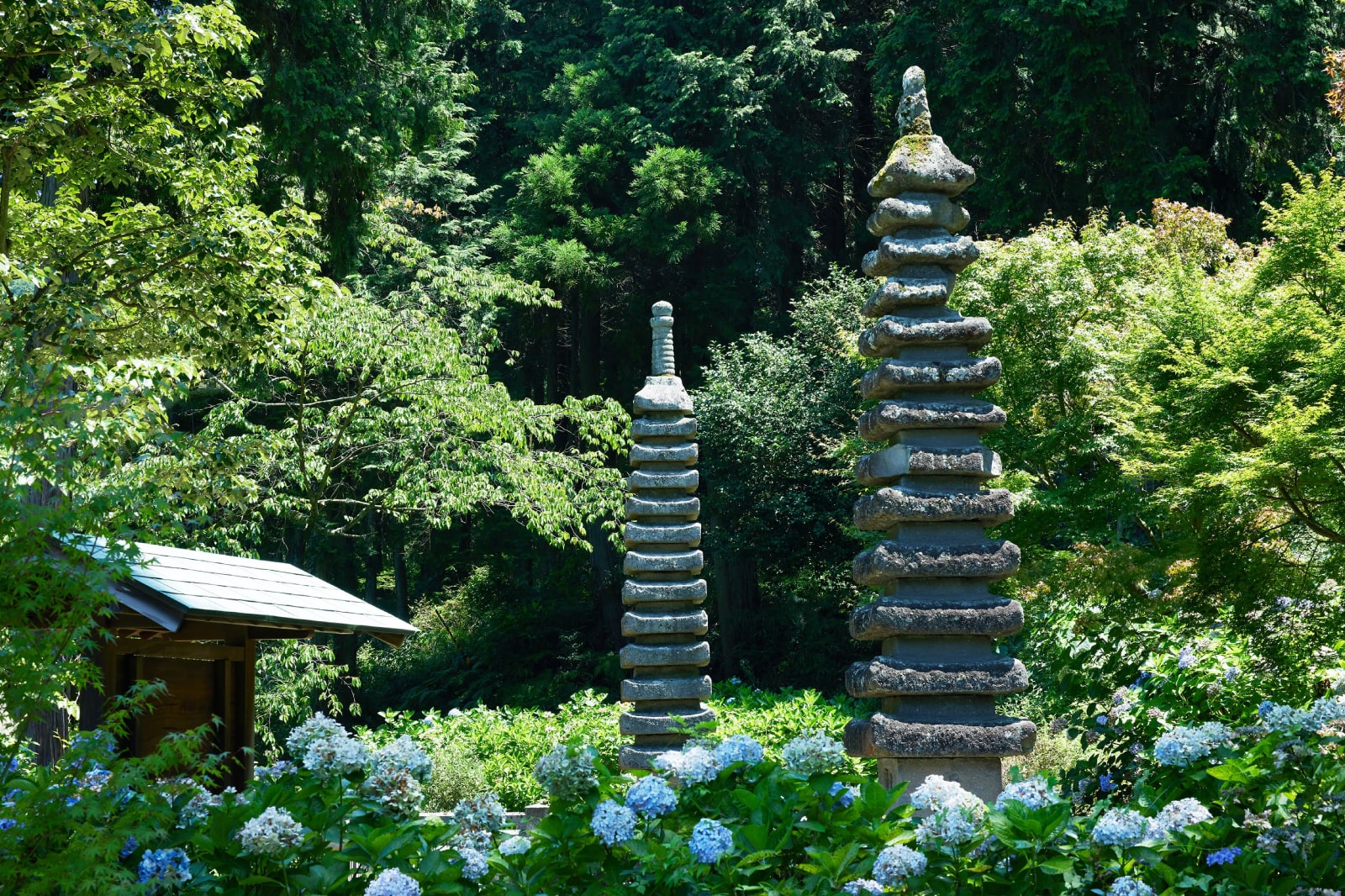
十三重石塔2基(重要文化財)JUSANJUSEKITO (TWO THIRTEEN-STOREY STONE PAGODAS) (IMPORTANT CULTURAL PROPERTIES)
白峯寺境内に至る道沿いに2基1対で造立されているもので、香川県最大規模の層塔である。源頼朝が崇徳上皇の菩提のために建立したと伝えられ、東塔は総高5.90mの花崗岩製で弘安元年(1278年)建立、西塔は総高5.62m火山礫凝灰岩製で元亨4年(1324年)建立。
A pair of thirteen-tiered stone pagodas stands along the path leading to Shiromineji Temple, the largest multi-tiered pagodas in Kagawa Prefecture. According to legend, Minamoto no Yoritomo had them built for the repose of Emperor Sutoku’s soul. The eastern pagoda, made of granite, stands 5.9 metres tall and was constructed in 1278, while the western pagoda, built of lapilli tuff, reaches a height of 5.62 metres and was erected in 1324.
ENGLISHCLOSE -
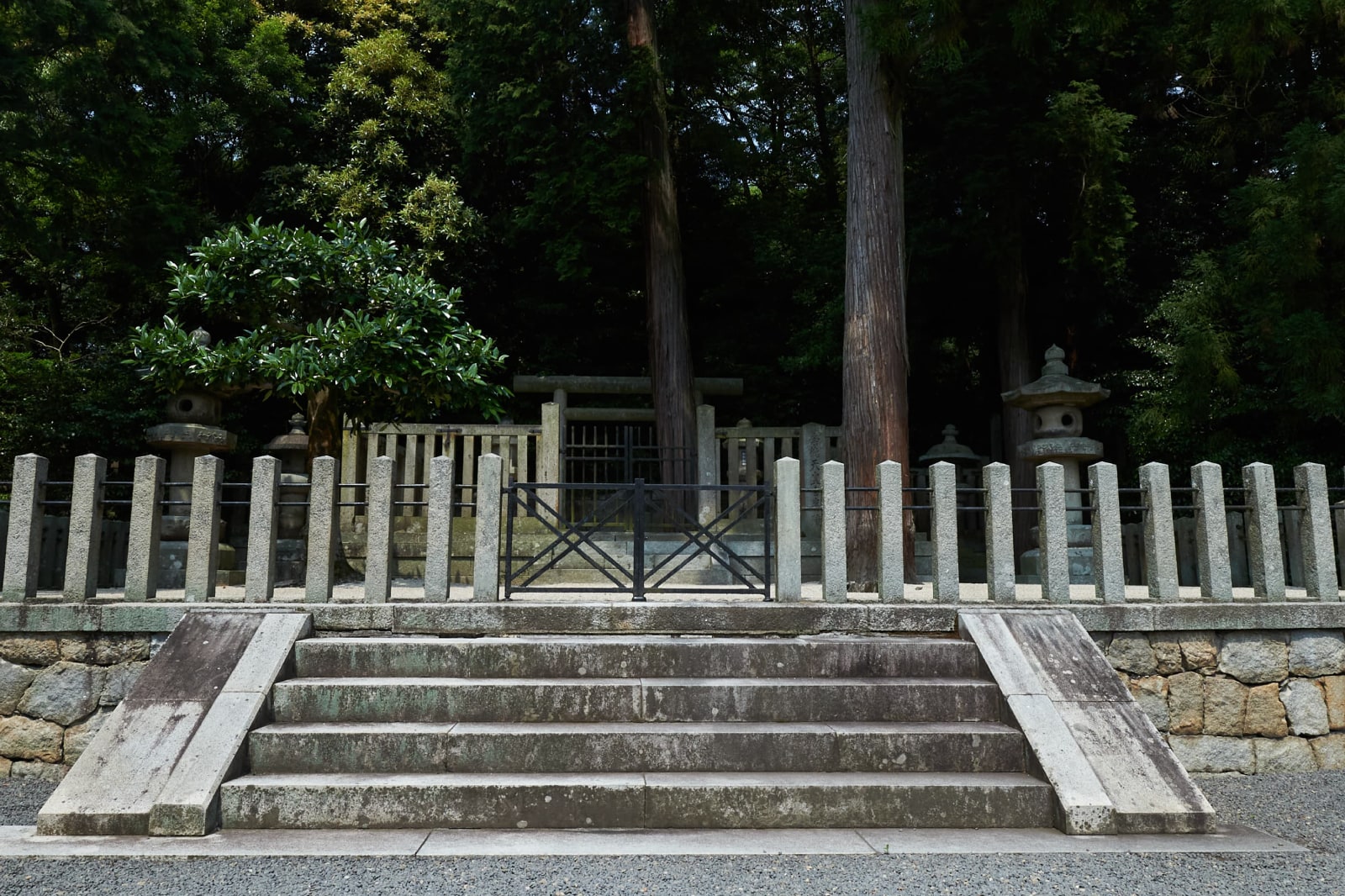
白峯御陵SHIROMINE GORYO (SHIROMINE IMPERIAL TOMB)
日本の第75代天皇である崇徳上皇が眠る墓所である。平安時代末期の1156年(保元元年)に貴族の内部抗争である保元の乱で後白河天皇に敗れ、讃岐に配流後は讃岐院とも呼ばれた。参道は門前トイレ裏の階段からと白峯寺境内の玉章の木の後ろから向かうことができ、頓証寺殿の後方にあり、陵形は方丘である。拝所内の前方一対の石燈籠は松平頼恭奉献、後方一対は松平頼重奉献である。また拝所下段右側に源為義(花崗岩製)、左側に源為朝(凝灰岩製)の供養塔が建っている。毎年9月21日に御正辰祭(ごしょうしんさい)の儀が執り行われ、だれでも参拝することができる。
This is the tomb of Emperor Sutoku, the 75th Emperor of Japan. After his defeat by Emperor Go-Shirakawa in the Hogen Rebellion, a conflict among the nobility in 1156 at the end of the Heian period, Emperor Sutoku was exiled to Sanuki Province (present-day Kagawa Prefecture), where he became known as the Sanuki Emperor.
The approach to the tomb can be accessed either from the steps behind the restrooms at the gate or from behind the tamazusa tree in the temple grounds. The tomb, a square-shaped mound, is located behind Tonshojiden. The pair of stone lanterns at the front were dedicated by Matsudaira Yoritaka, while the pair at the back were dedicated by Matsudaira Yorishige. In addition, there are memorial towers for Minamoto no Tameyoshi (made of granite) on the right side and Minamoto no Tametomo (made of tuff) on the left side.
Every year on September 21st, the Goshoshinsai (Memorial Service for Emperor Sutoku) is held, and the service is open to the public.ENGLISHCLOSE -
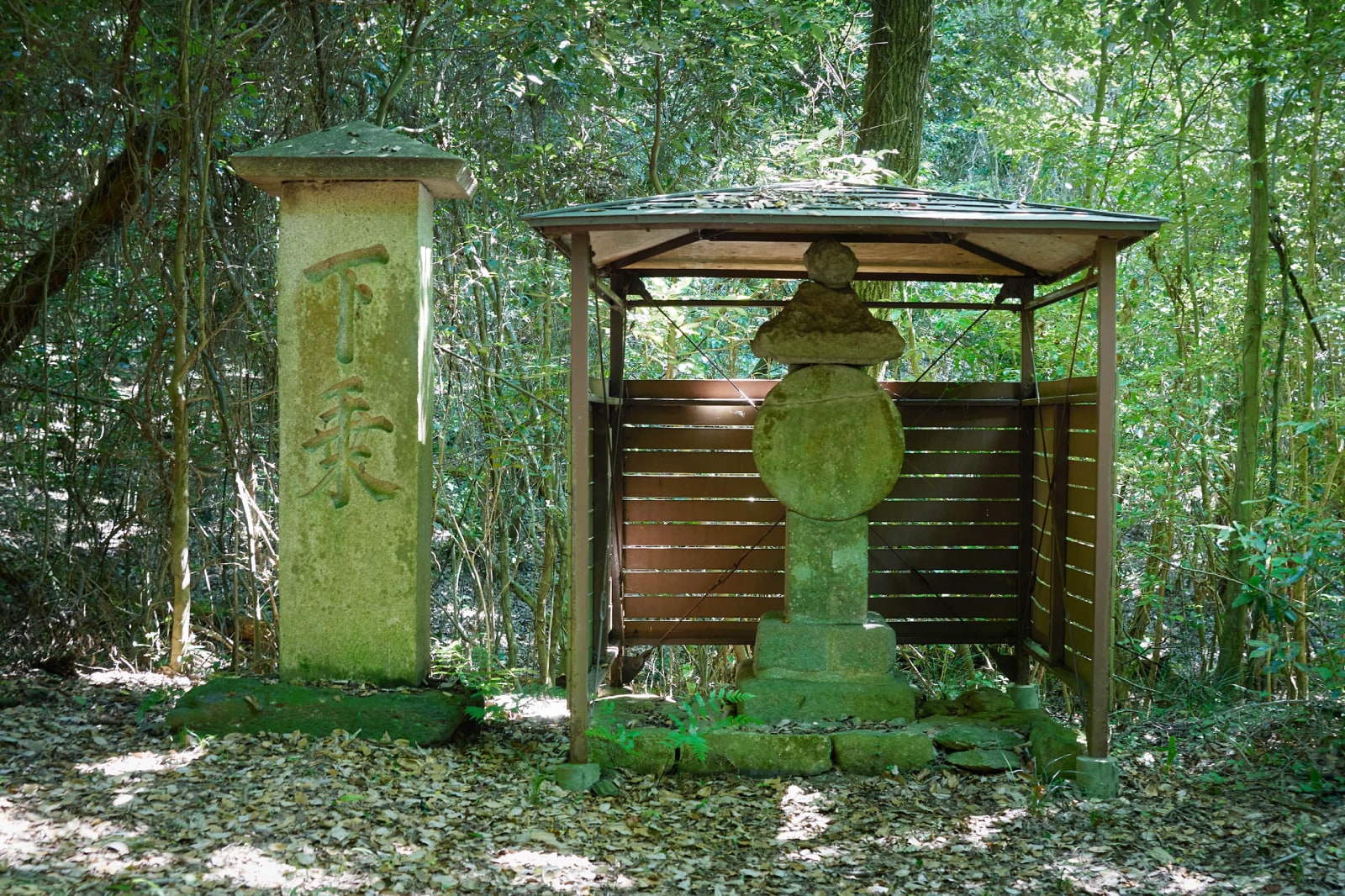
摩尼輪塔と下乗石(県指定文化財)MANIRINTO AND GEJOISHI (MANI WHEEL TOWER AND DISMOUNTING STONE) (PREFECTURAL CULTURAL PROPERTIES)
ここから先は聖地であるゆえどんな高貴な者でも乗り物からおりて自分で歩いて参拝しなさいという印。根香寺に向かう遍路道である根香寺道の途中に摩尼輪塔と笠塔婆形下乗石があり、坂出方面からの参道途中にある白峰展望台付近の広場の中心に笠塔婆形下乗石と一ノ門の裏に摩尼輪塔型下乗石がある。根香寺道途中にある古い摩尼輪塔(県文化財)は小屋で覆い保存し、隣には天保7年3月(1836年)に高松藩が建てた由緒を背面に刻んだ笠塔婆形下乗石がある。また旧参道の1つである神谷道沿いにも笠塔婆形下乗石が残されており、現在は上記を含めた全部で5つの下乗石が現認できる。
These markers indicated the entrance to a sacred area, signalling that all pilgrims, regardless of their status, had to dismount their horses or vehicles and continue on foot.
Along the Negoroji-Michi pilgrimage trail leading to Negoroji Temple, there is a manirinto (mani wheel tower) and a gejoishi (dismounting stone). A gejoishi can also be found near the Shiromine Observation Deck on the approach from Sakaide, as well as behind the Ichinomon Gate.
An old manirinto, designated as a Prefectural Cultural Property, is located on the Negoroji-Michi trail and is protected by a hut. Next to it stands a gejoishi erected by the Takamatsu Domain in March 1836, with its history inscribed on the back. Another gejoishi can be found along the old Kandani-Michi pilgrimage trail.
In total, five gejoishi, including those mentioned above, can be seen today.ENGLISHCLOSE -
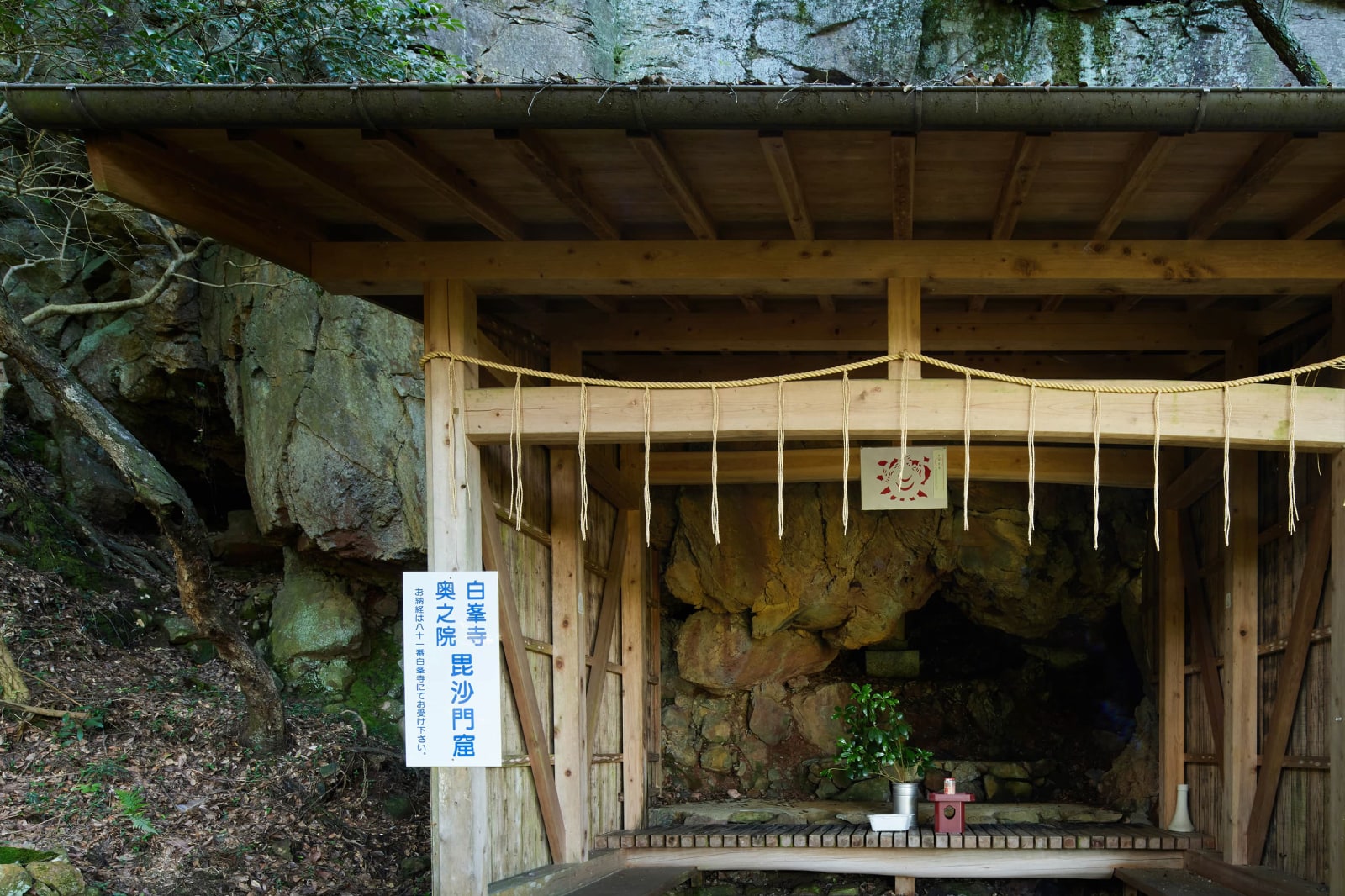
奥之院(毘沙門窟)OKUNOIN (BISHAMON CAVE)
摩尼輪塔を越えて根香寺道を進むと左側に奉献毘沙門天の文字が刻まれた立派な石灯篭があり、左折し石畳の道を行くと一対の石燈籠がある。更に険しい石段を下って行くと覆屋根があり、毘沙門天立像が刻まれた舟形石が岩窟の中に鎮座している。少々崖を下りるため注意が必要、雨天時は足元に更に注意が必要となる。※徒歩のみ 白峯寺より約15分 。また近くに無名の滝があり、滝音が聞こえる。
If you pass the manirinto (mani wheel tower) on Negoroji-Michi and continue along the pilgrimage trail, you will come across an impressive stone lantern on the left, inscribed with the words "Dedicated to Bishamonten." If you then turn left and follow the stone-paved path, you will reach a pair of stone lanterns. Continue down the steep stone steps, and you will arrive at a roofed area, where a boat-shaped stone in a cave bears a carving of a standing image of Bishamonten.
Be cautious when descending the cliff, especially in rainy weather, as the path may be slippery.
*This trail is only accessible on foot and takes about 15 minutes to walk from Shiromineji Temple. An unnamed waterfall is also nearby, and you can hear its sound as you approach.ENGLISHCLOSE -
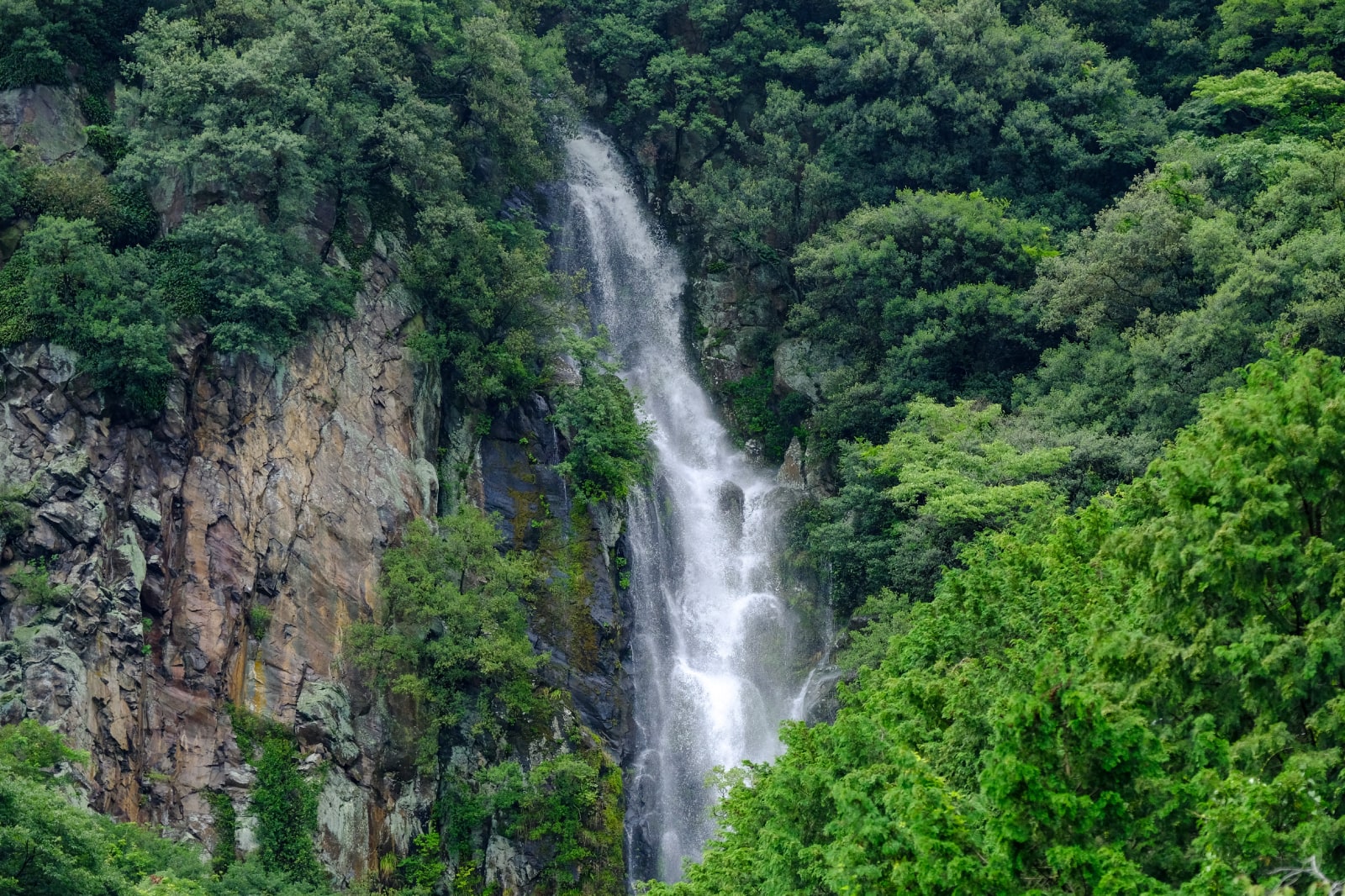
稚児ヶ滝CHIGOGATAKI FALLS
白峯寺前と白峯陵の前を通過する青海川の支流で、稚児ヶ嶽より流れ落ち大雨の後は約100mの落差の大滝であるが、普段は湿っている程度で水量が少ないため、幻の滝ともいわれる。伝説として、昔このあたりに悪魚が出て困っていた際に、景行天皇は日本武尊(武皷王とも)と88の兵士を派遣し退治したが、魚の毒気に当たった兵士達は倒れてしまった。その時、白峰山から神童が現れ持参した瓶に入った水を飲ますと皆蘇った。その神童が飛び帰ったのが稚児ヶ嶽といい、そこから稚児ヶ滝と名付けられた。
A tributary of the Omigawa River flows down from Mt. Chigogadake, passing in front of Shiromineji Temple and Emperor Sutoku’s tomb. After heavy rains, it becomes a powerful waterfall with a drop of about 100 metres. However, it is usually just a trickle, earning it the nickname "phantom waterfall."
According to legend, the area was once plagued by a monstrous fish. Emperor Keiko sent his son, Yamato Takeru, along with 88 soldiers to subdue it, but the soldiers collapsed after being poisoned by the fish. At that moment, a divine child appeared from Mt. Shiromine, carrying water in a sacred vessel. After drinking the water, the soldiers recovered. The divine child then flew back to Mt. Chigogadake, and the waterfall came to be known as Chigogataki Falls.ENGLISHCLOSE -
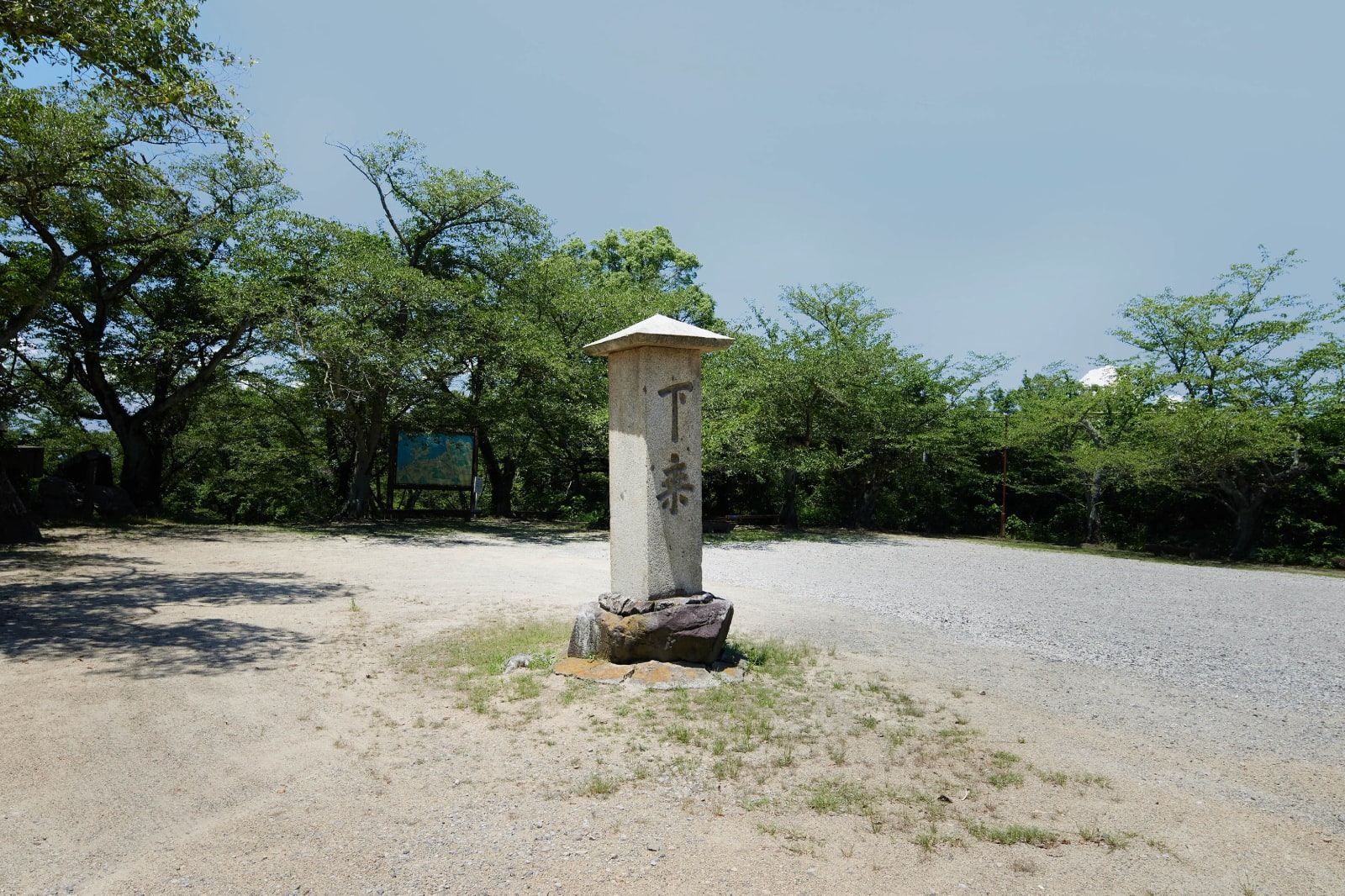
白峰園地SHIROMINE PARK
この付近一帯は元々白峯寺の塔頭である西之坊があったが時代と共に衰退し、現在は白峰園地として整備されている。園地内には瀬戸内海が一望できる白峰展望台、公共トイレ、初代坂出市長像、自彊術創始者記念碑と石燈篭、下乗石があり、春は白峯寺の参道と合わせて多くの桜が満開を迎える。
This area was originally the site of Nishinobo, a sub-temple of Shiromineji, but it gradually declined over time and is now maintained as Shiromine Park. Within the park, an observation deck offers sweeping views of the Seto Inland Sea. The park also features public restrooms, a statue of the first mayor of Sakaide, a monument to the founder of jikyojutsu (a traditional Japanese exercise method), a stone lantern, and a gejoishi (dismounting stone). In spring, the park and the approach to Shiromineji Temple are adorned with blooming cherry trees.
ENGLISHCLOSE -
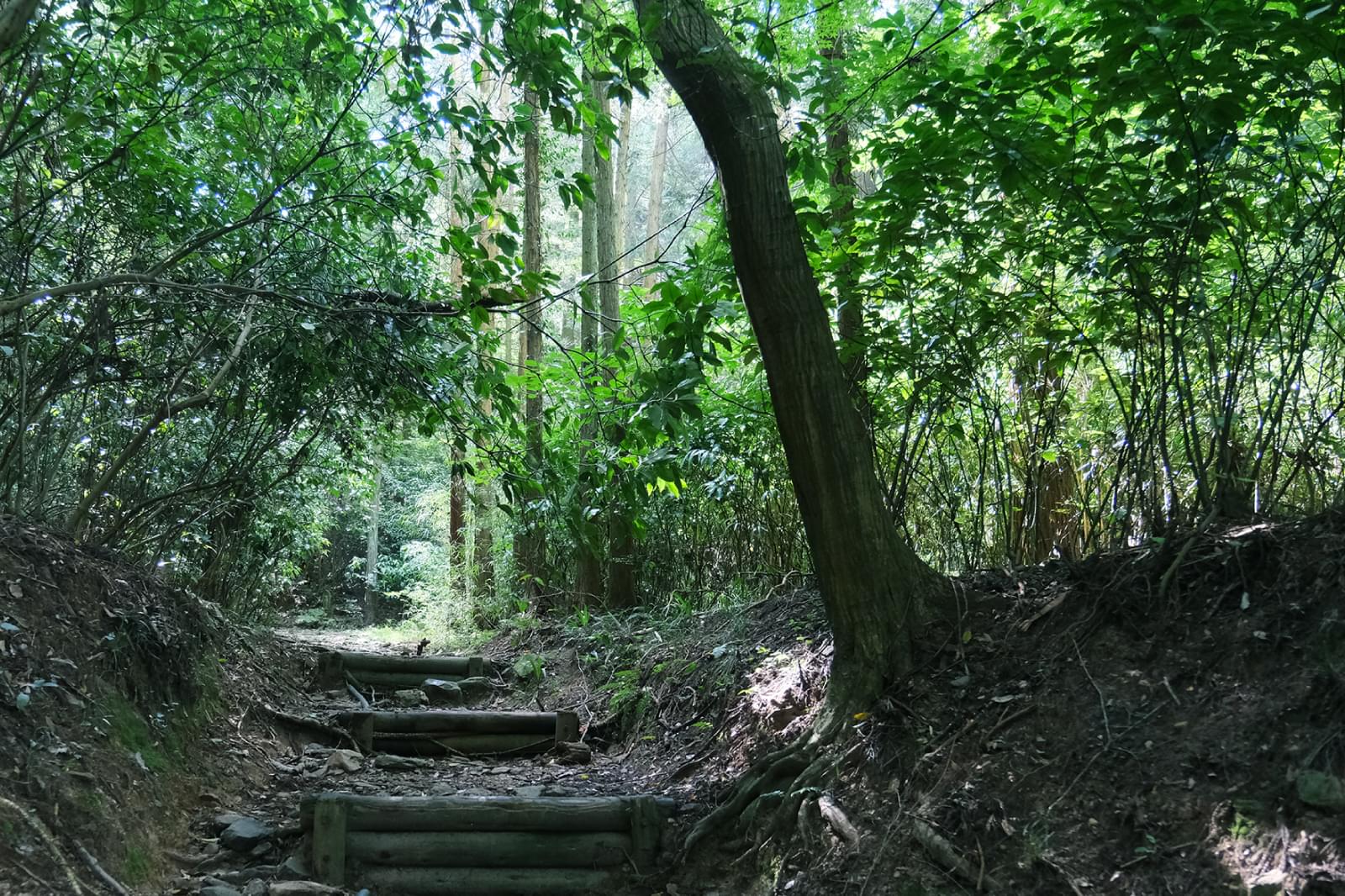
根香寺道(史跡)NEGOROJI-MICHI PILGRIMAGE TRAIL (HISTORIC SITE)
香川県には約185kmの遍路道があり、その中でも第81番札所白峯寺から第82番札所根香寺に至る遍路道「根香寺道」は、五色台にまたがる舗装されていない山道であり、道沿いには道標、丁石も数多く残っており、歴史的な景観を現在も良くとどめている。「根香寺道」は歴史的には江戸時代前期まで遡ることができ、景観面でも昔の状態を良く残していると考えられるため、その価値を認められその一部が平成25年(2013年)10月17日に国の史跡に指定された。
The pilgrimage trails in Kagawa Prefecture stretch for approximately 185 kilometres, including Negoroji-Michi, which connects Temple 81, Shiromineji, to Temple 82, Negoroji. This mountain trail, unpaved and spanning the Goshikidai Plateau, retains its historic landscape, with route signs and marker stones along the way.
Negoroji-Michi dates back to the early Edo period (Edo period: 1600-1868). Due to its well-preserved historical landscape and cultural significance, part of the trail was designated a National Historic Site on October 17, 2013.ENGLISHCLOSE -
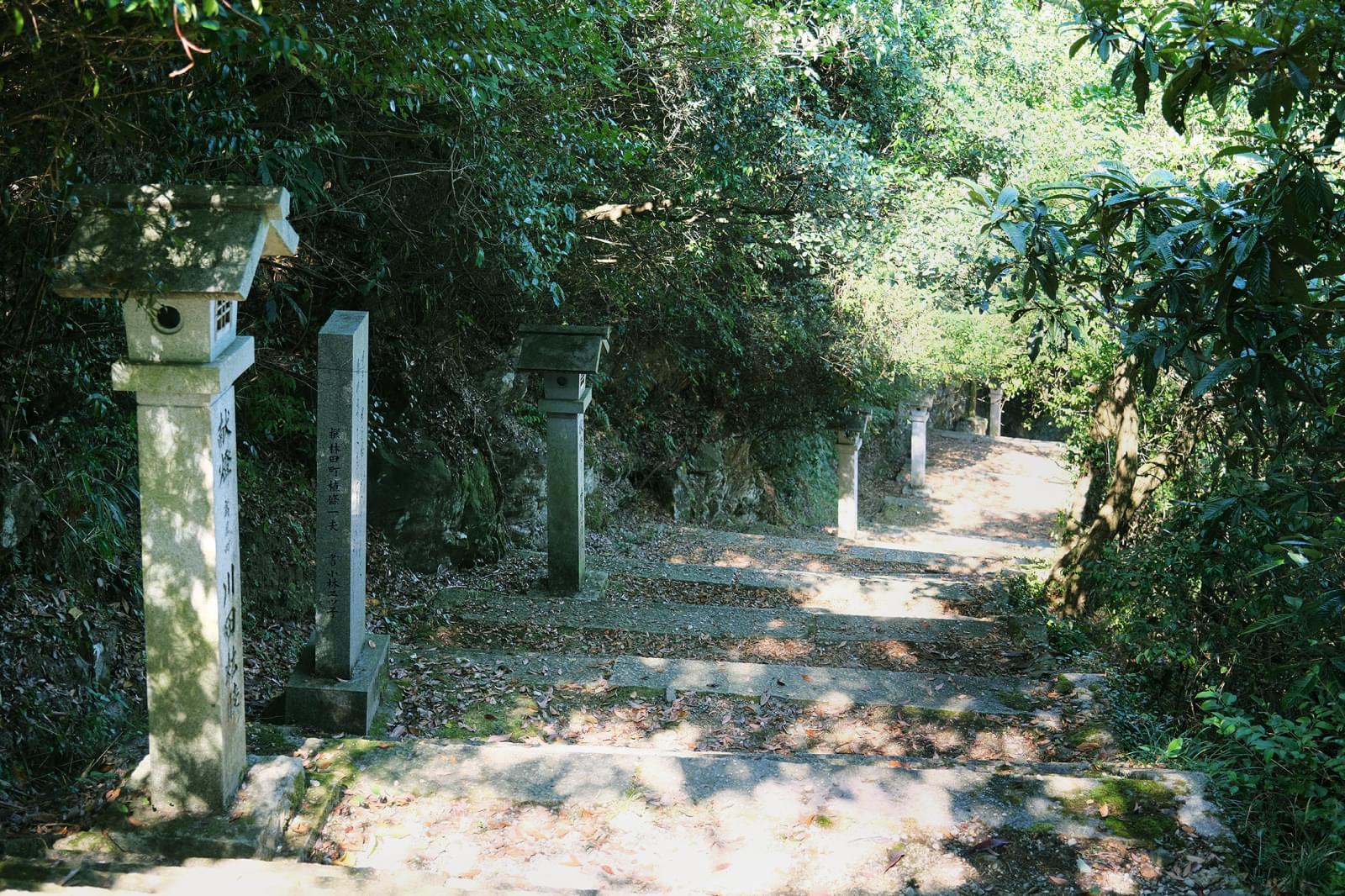
西行法師の道SAIGYO HOSHI NO MICHI (SAIGYO HOSHI ROAD)
崇徳上皇が讃岐で没して3年後の仁安3年(1168年)に西行法師が崇徳上皇を偲んで御陵を詣でたとされる。青海神社から白峯御陵までの道のり約1.34キロを「西行法師の道」として平成15年(2003年)に新たに整備したもの。道沿いには西行法師や崇徳院に因んだ歌を刻んだ歌碑88基と石燈籠93基が設置されている。
In 1168, three years after Emperor Sutoku passed away in Sanuki (present-day Kagawa Prefecture), the poet-monk Saigyo Hoshi is said to have visited the Emperor’s tomb. In 2003, a new 1.34 km road from Omi Shrine to Emperor Sutoku’s tomb was constructed and named Saigyo Hoshi Road. Along the road, there are 88 stone monuments inscribed with poems related to Saigyo Hoshi and Emperor Sutoku, as well as 93 stone lanterns.
ENGLISHCLOSE
